
The guard moves and captures like king. The guard doesn't have any special power - losing it does not lose the game.'
Diagram: white guard can move to any empty green square or can capture black knight.
|
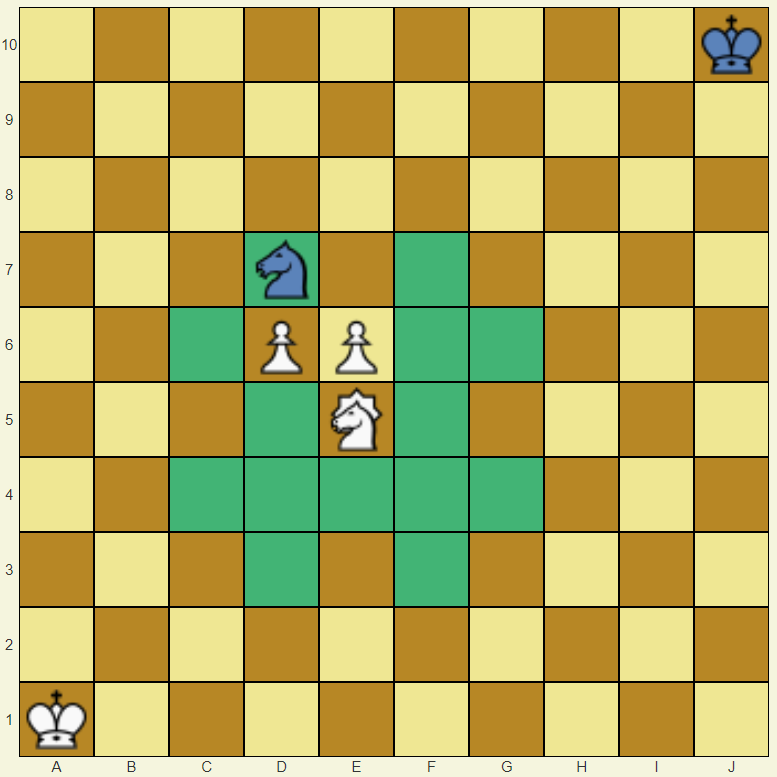
The centaur moves and captures like guard (one adjacent square) or like knight (jumper(2,1)).
Diagram: white centaur can move to any empty green square or can capture black knight.
|

The amazon moves and captures like queen or like knight (jumper(2,1)).
Diagram: white amazon can move to any empty green square or can capture black knight.
|
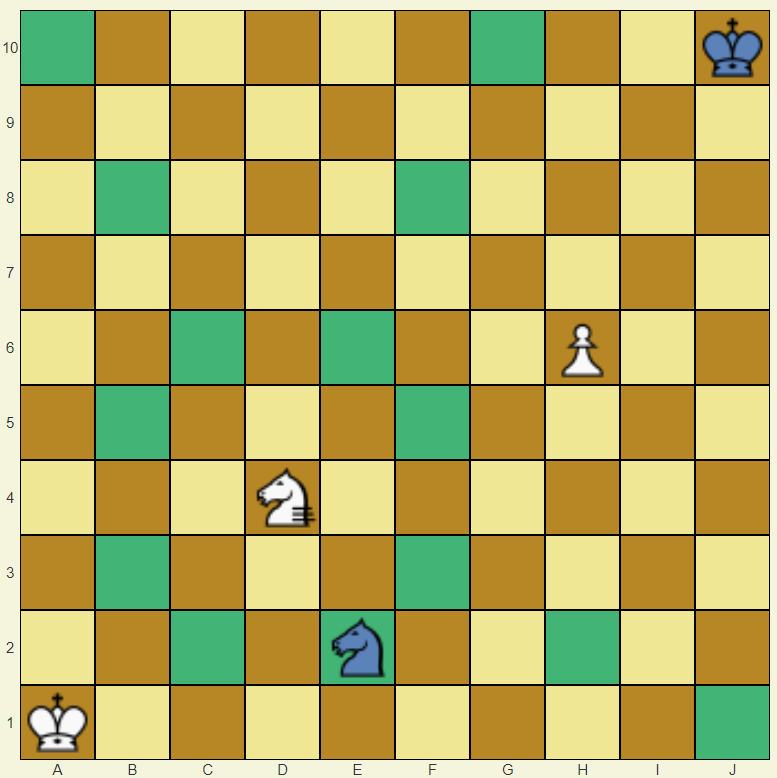
The knightrider can make a move like a knight, but then can continue to move in the same direction.
Thus, it can make one or more successive knight-leaps, all in the same direction: the spaces visited by all but the last jump must be empty.
The knightrider can give a check on move 1 so it is frozen for the first 5 moves so the players can take care of potential threats.
Diagram: white knightrider can move to any empty green square or can capture black knight.
|
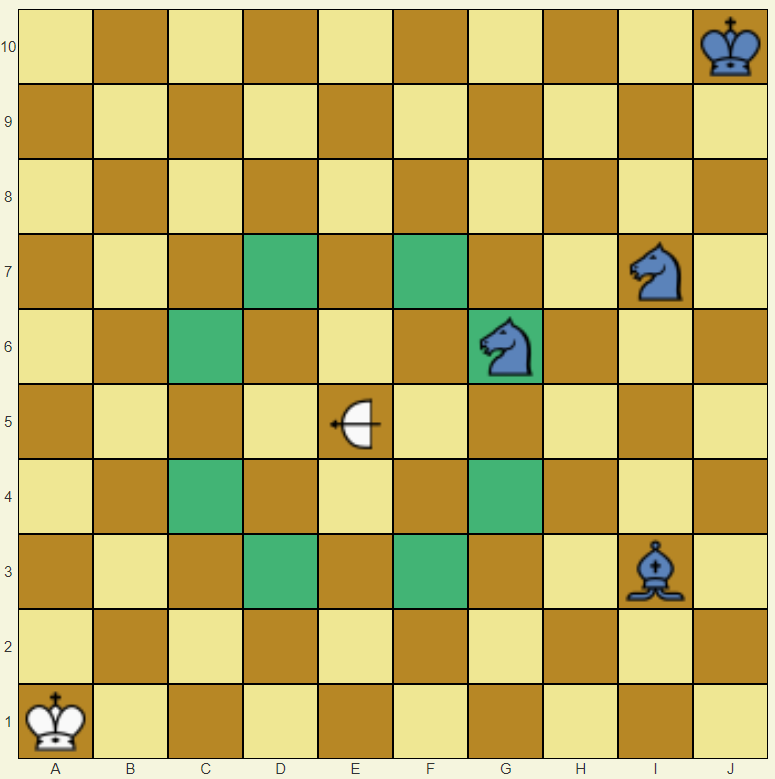
The archer can make a move like a knight. The archer captures by moving as the knight normally does.
Additionally, if there is a piece located another knight move in the same direction away from the archer's destination square, then that piece is captured,
regardless of intervening pieces. The archer does not actually move to the second square in the same direction, thus it captures 'from afar'.
Thus the archer can capture two pieces with a single move: one like a normal knight move and another 'from afar'.
Capture 'from afar' is part of the movement, and is mandatory.
Diagram: white archer can move to any empty green square or can capture both black knights by moving to G6.
The archer can also capture black bishop by moving to G4.
If the black king was placed instead of the knight I7, then the resulting position would be illegal as white archer could capture the black king
by capturing knight G6 on the way. If it was black to move, then the black king would be in check and would need to eliminate the threat by moving
away or by capturing the archer with the knight.
|
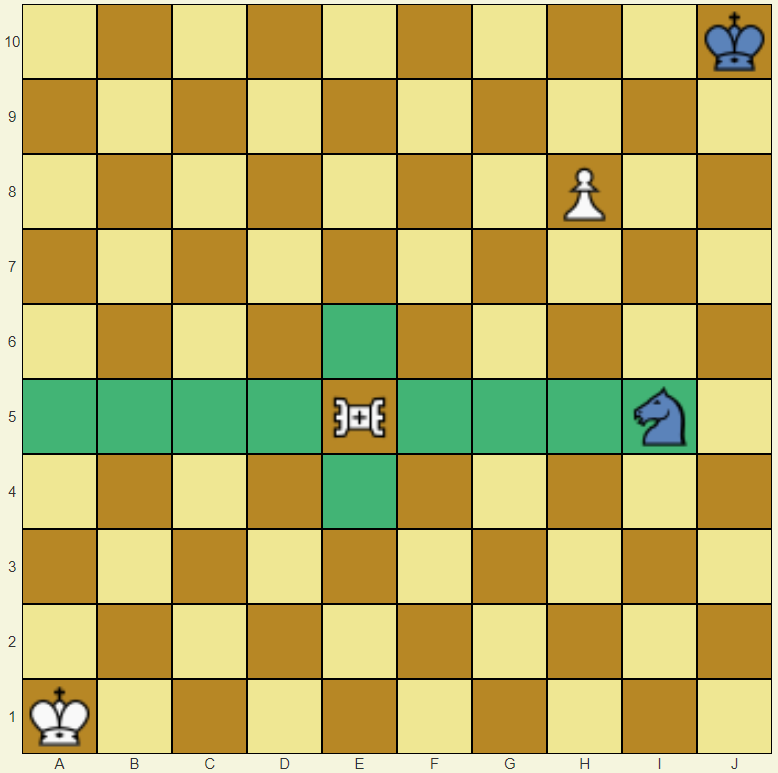
The side mover moves horizontally through any number of unoccupied squares. Also the side mover can move one square directly forward or backward.
The side mover captures the same way as it moves.
Diagram: white side mover can move to any empty green square or can capture black knight.
|
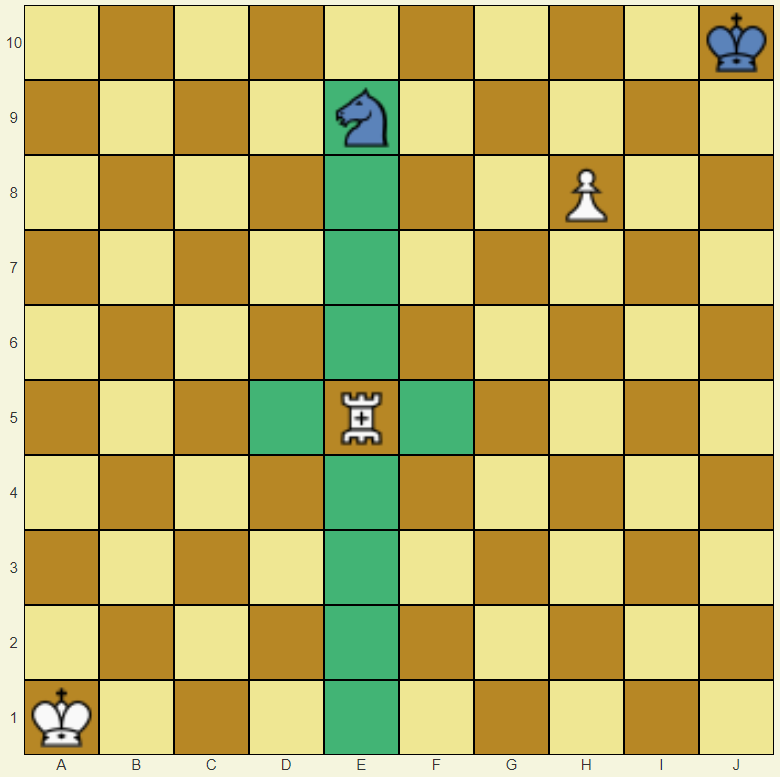
The vertical mover moves vertically through any number of unoccupied squares. Also the vertical mover can move one square directly left or right.
The vertical mover captures the same way as it moves.
Diagram: white vertical mover can move to any empty green square or can capture black knight.
|
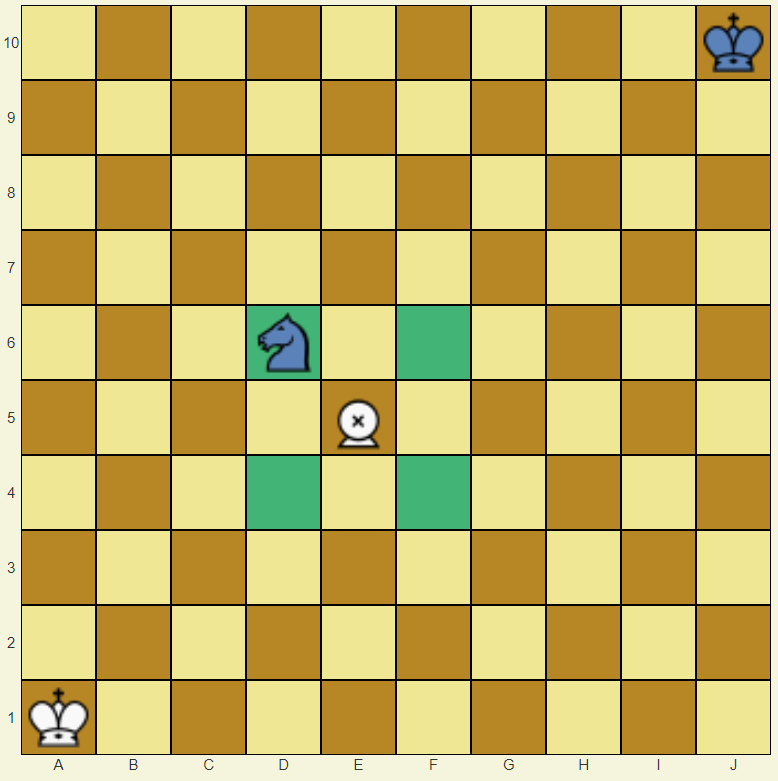
The ferz moves and captures one square diagonally.
Diagram: white ferz can move to any empty green square or can capture black knight.
|
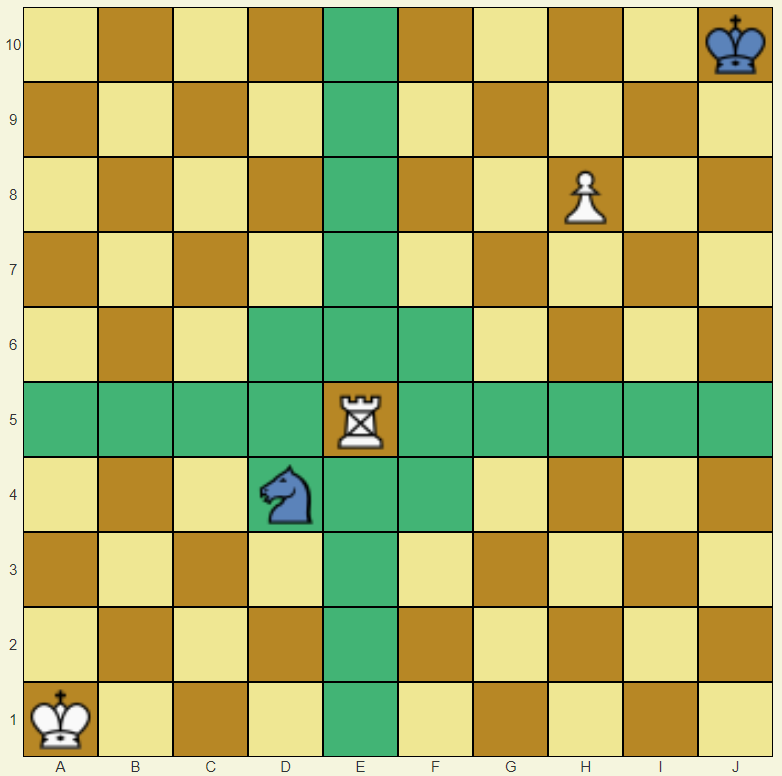
The dragonking moves and captures like rook or like ferz (one square diagonally).
Diagram: white dragonking can move to any empty green square or can capture black knight.
|
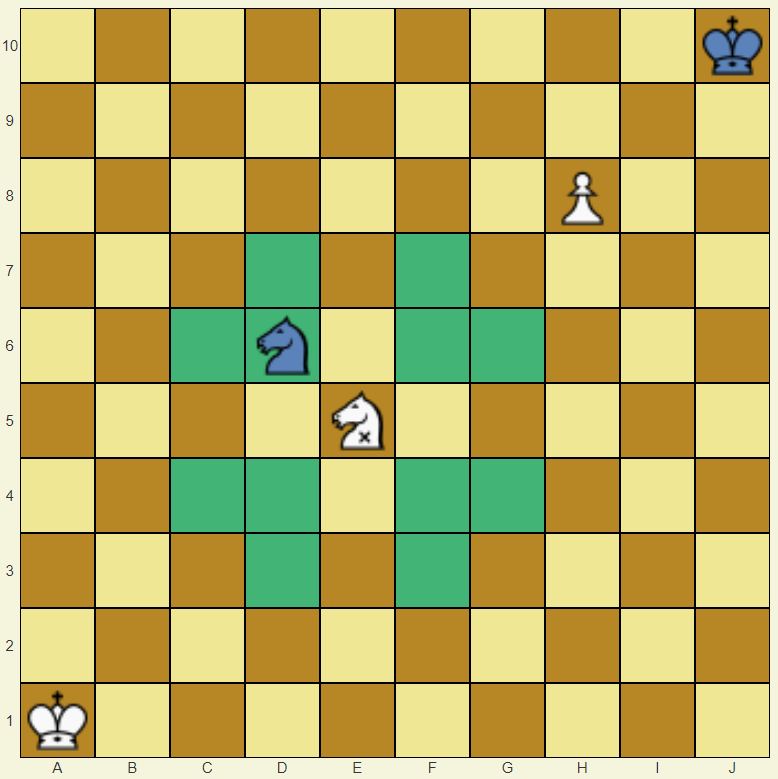
The knight-ferz moves and captures like knight (jumper(2,1)) or like ferz (one square diagonally).
Diagram: white knight-ferz can move to any empty green square or can capture black knight.
|
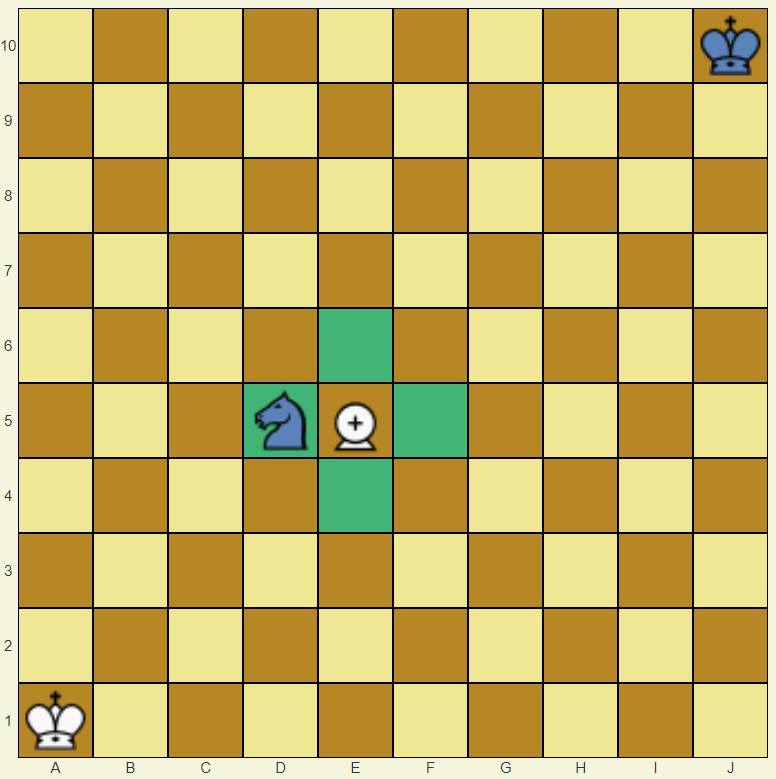
The wazir moves and captures one square orthogonally.
Diagram: white wazir can move to any empty green square or can capture black knight.
|
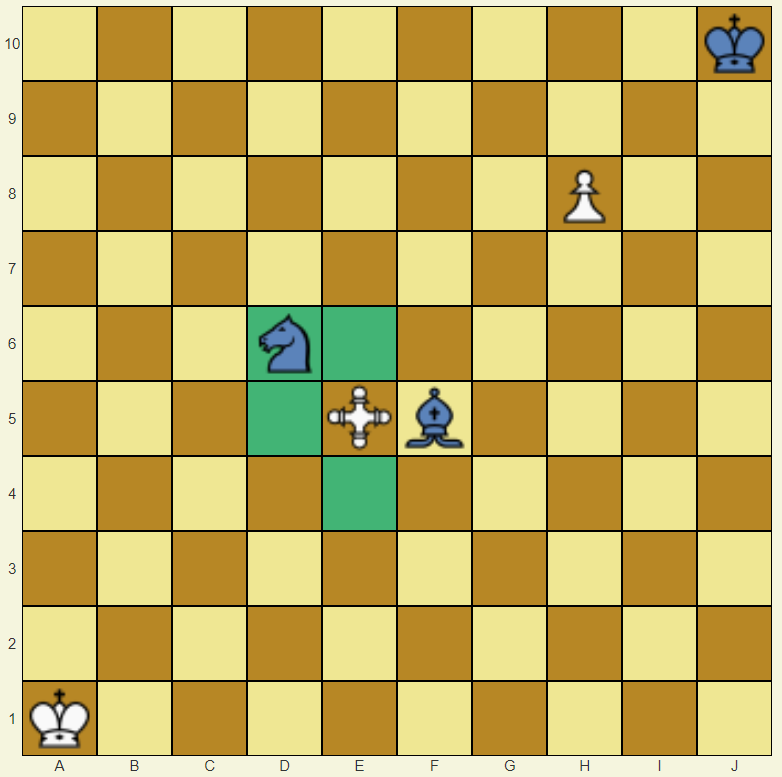
The steward moves like wazir (one square orthogonally). The steward captures like ferz (one square diagonally).
Diagram: white steward can move to any empty green square or can capture black knight. Note: steward cannot capture black bishop as it captures differently than it moves.
|
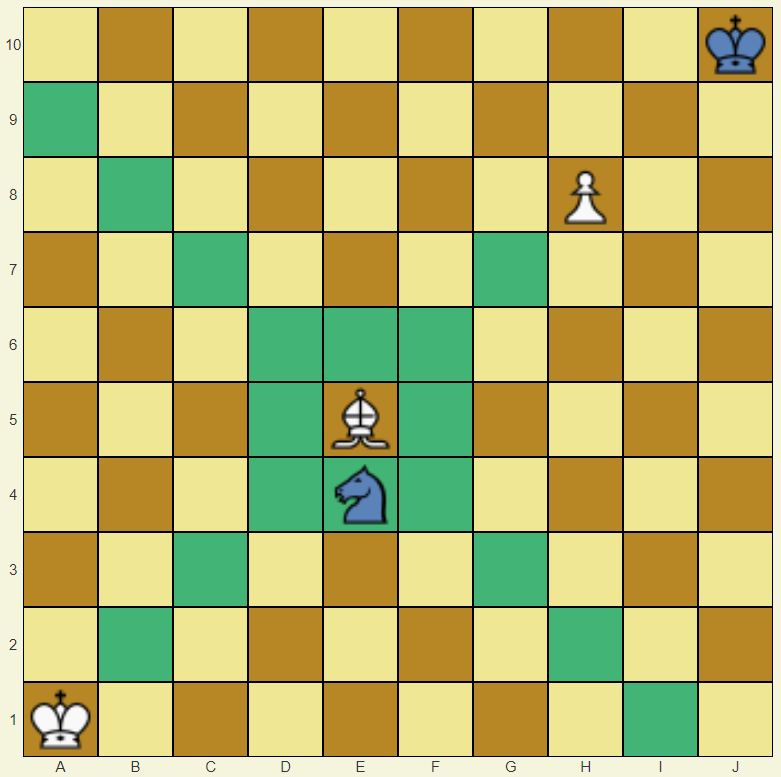
The dragonhorse moves and captures like bishop or like wazir (one square orthogonally).
Diagram: white dragonhorse can move to any empty green square or can capture black knight.
|
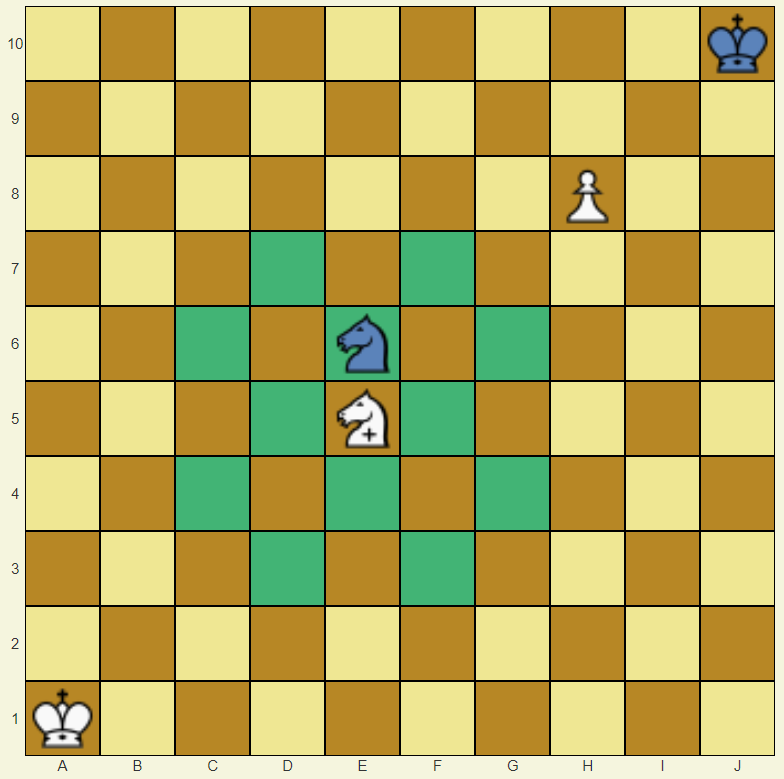
The knight-wazir moves and captures like knight (jumper(2,1)) or like wazir (one square orthogonally).
Note: on an empty board knight-wazir can move to the same squares as rhino. The difference comes when the fist square orthogonally is blocked.
Diagram: white knight-wazir can move to any empty green square or can capture black knight.
|

The rhino moves and captures one square orthogonally, and then optionally, only if the first square was empty, one square diagonally outward.
Note: on an empty board rhino can move to the same squares as knight-wazir. The difference comes when the fist square orthogonally is blocked.
Diagram: white rhino can move to any empty green square or can capture black knight.
|

The elephant is a jumper(2,2). It moves and captures two squares diagonally. It "jumps", i.e., it can move regardless whether there is a piece on the intervening square.
Diagram: white elephant can move to any empty green square or can capture black knight.
|

The phoenix moves and captures like elephant (jumper(2,2)) or like wazir (one square orthogonally).
Diagram: white phoenix can move to any empty green square or can capture black knight.
|
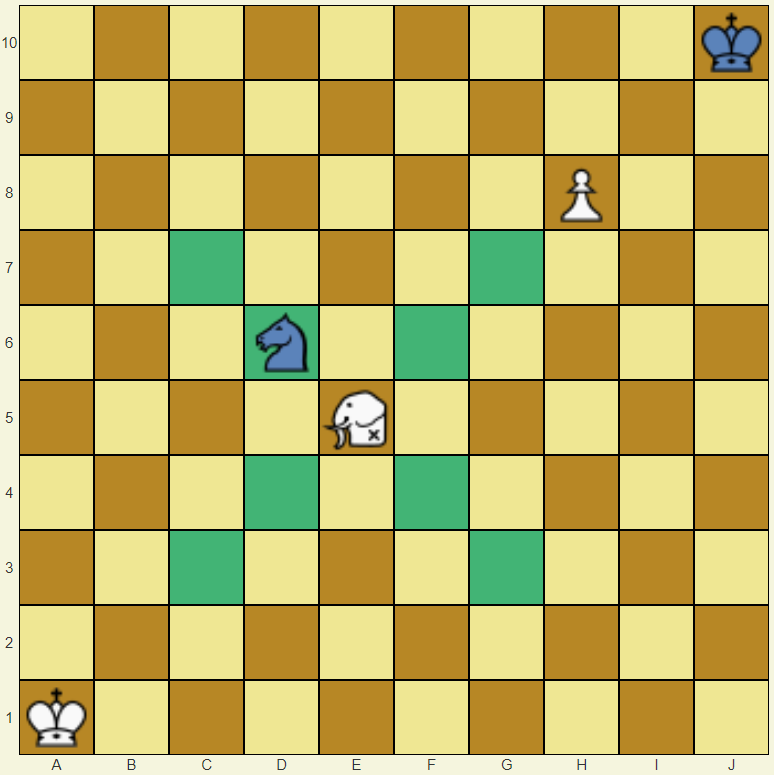
The modern elephant moves and captures like elephant (jumper(2,2)) or like ferz (one square diagonally).
Diagram: white modern elephant can move to any empty green square or can capture black knight.
|
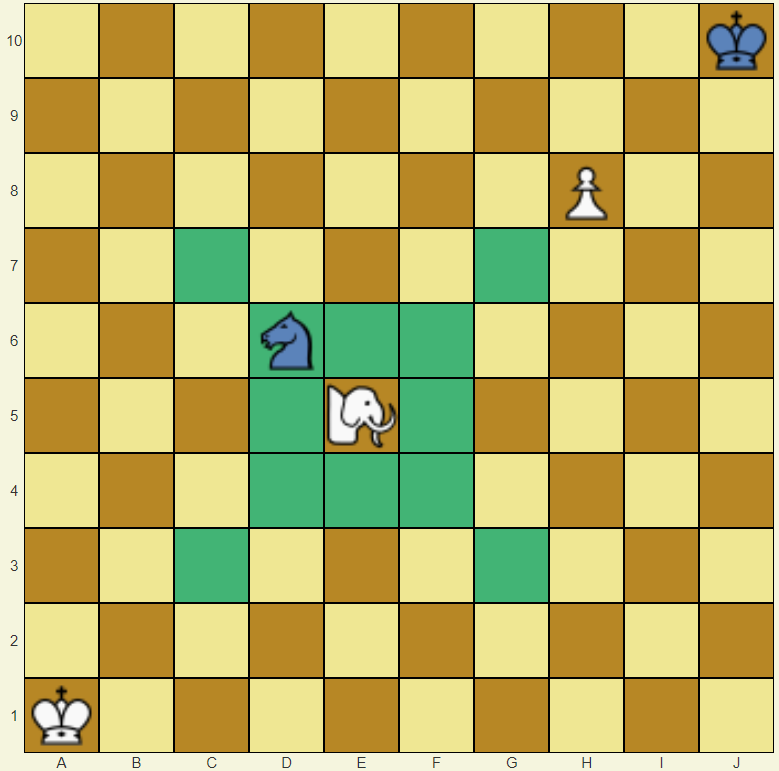
The mammoth moves and captures like elephant (jumper(2,2)) or like guard (one adjacent square).
Diagram: white mammoth can move to any empty green square or can capture black knight.
|
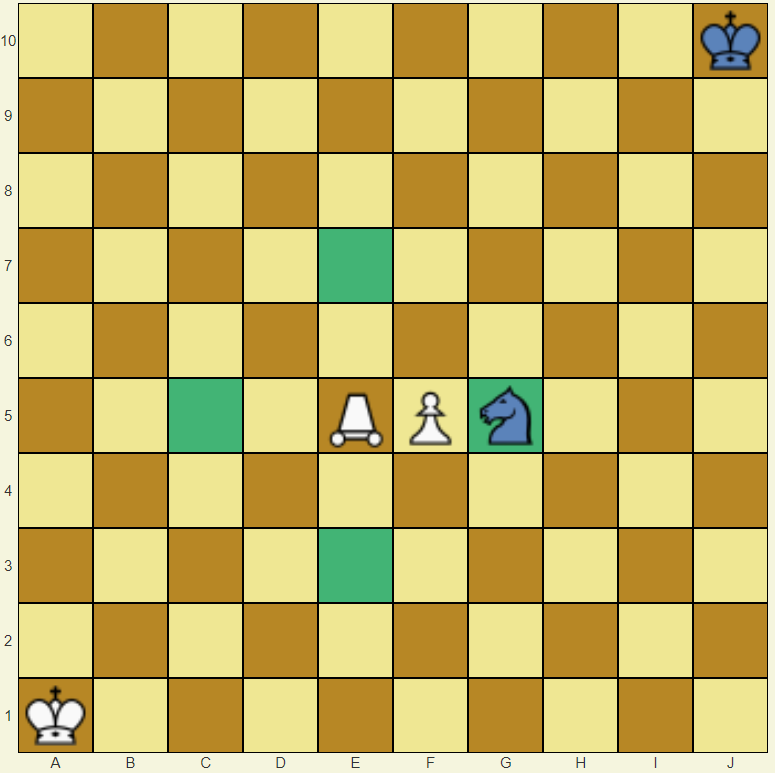
The dabbaba is a jumper(2,0). It moves and captures two squares orthogonally. It "jumps", i.e., it can move regardless whether there is a piece on the intervening square.
Diagram: white dabbaba can move to any empty green square or can capture black knight.
|
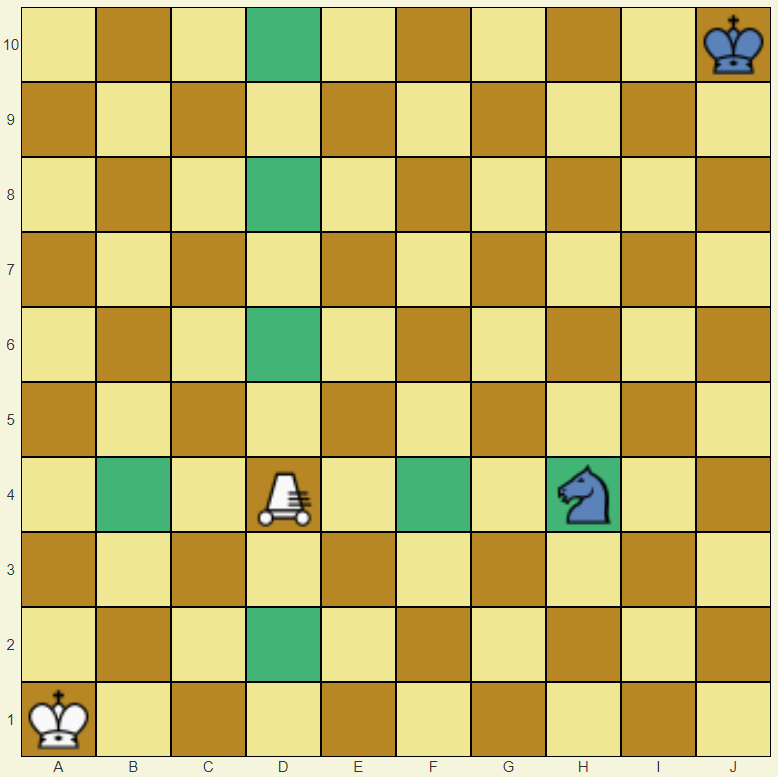
The dabbabarider can make a move like a dabbaba, but then can continue to move in the same direction.
Thus, it can make one or more successive dabbaba-leaps, all in the same direction: the spaces visited by all but the last jump must be empty.
The dabbabarider can give a check on move 1 so it is frozen for the first 5 moves so the players can take care of potential threats.
Diagram: white dabbabarider can move to any empty green square or can capture black knight.
|
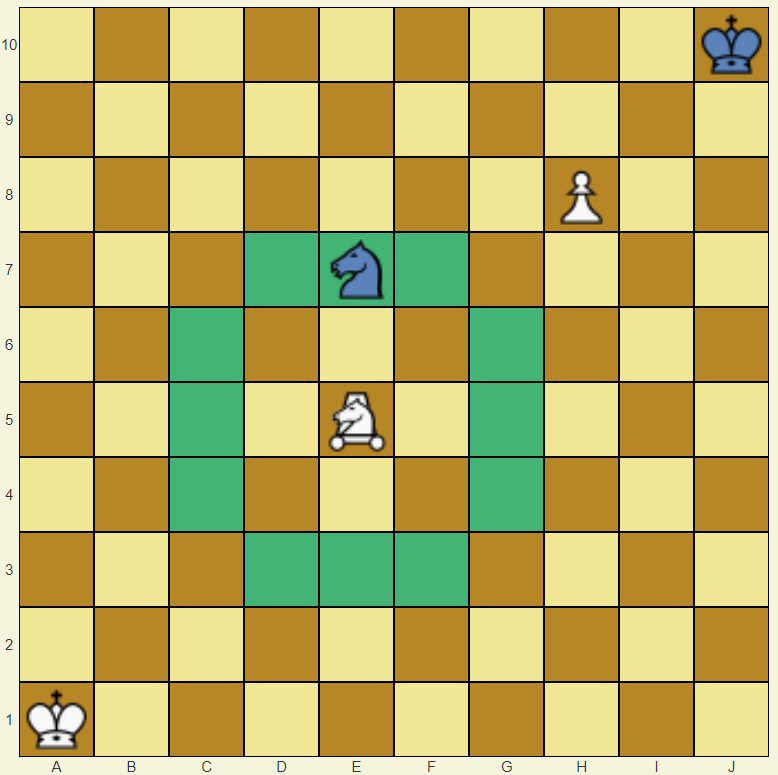
The knight-dabbaba moves and captures like knight (jumper(2,1)) or like dabbaba (jumper(2,0)).
Diagram: white knight-dabbaba can move to any empty green square or can capture black knight.
|
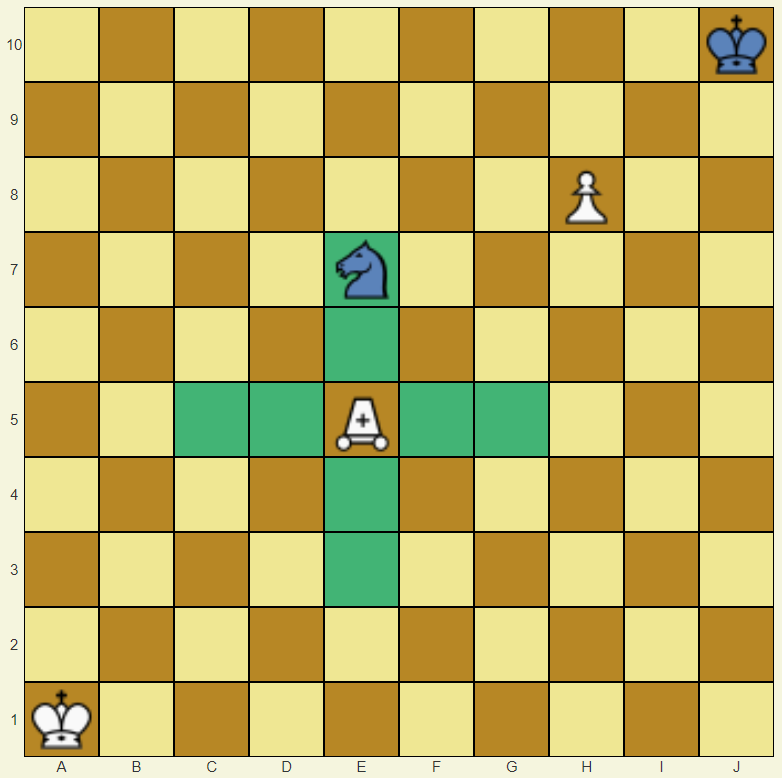
The dabbaba-wazir moves and captures like dabbaba (jumper(2,0)) or like wazir (one square orthogonally).
Diagram: white dabbaba-wazir can move to any empty green square or can capture black knight.
|
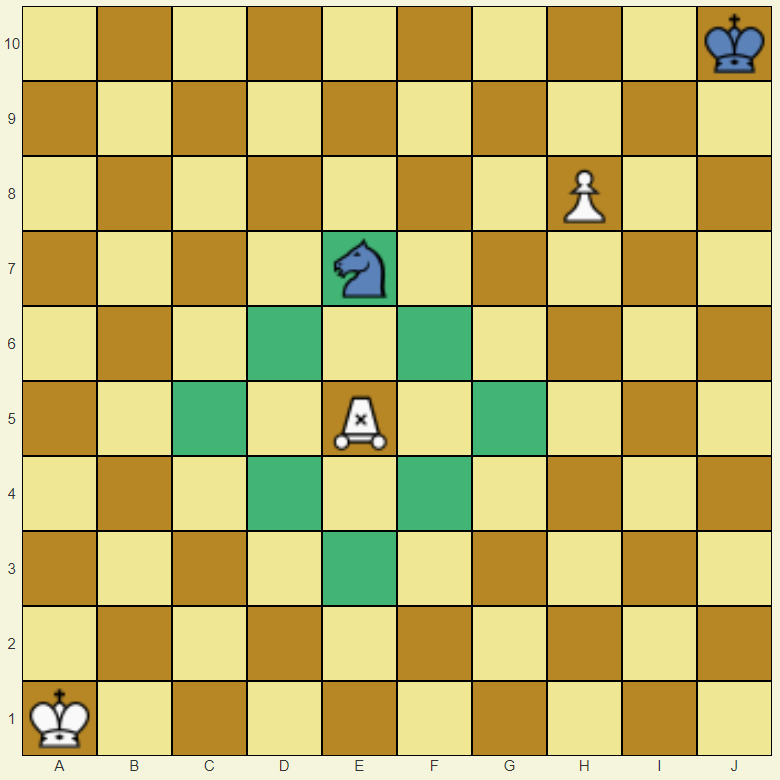
The kirin moves and captures like dabbaba (jumper(2,0)) or like ferz (one square diagonally).
Diagram: white kirin can move to any empty green square or can capture black knight.
|

The alibaba moves and captures like elephant (jumper(2,2)) or like dabbaba (jumper(2,0)).
Diagram: white alibaba can move to any empty green square or can capture black knight.
|

The badger moves and captures like bishop or like dabbaba (jumper(2,0)).
Diagram: white badger can move to any empty green square or can capture black knight.
|

The ox moves like knight (jumper(2,1)) or like dabbaba (jumper(2,0)) or
like elephant (jumper(2,2)). The ox captures like ferz (one square diagonally).
Diagram: white ox can move to any empty green square or can capture black knight. Note: ox cannot capture black bishop as it captures differently than it moves.
|
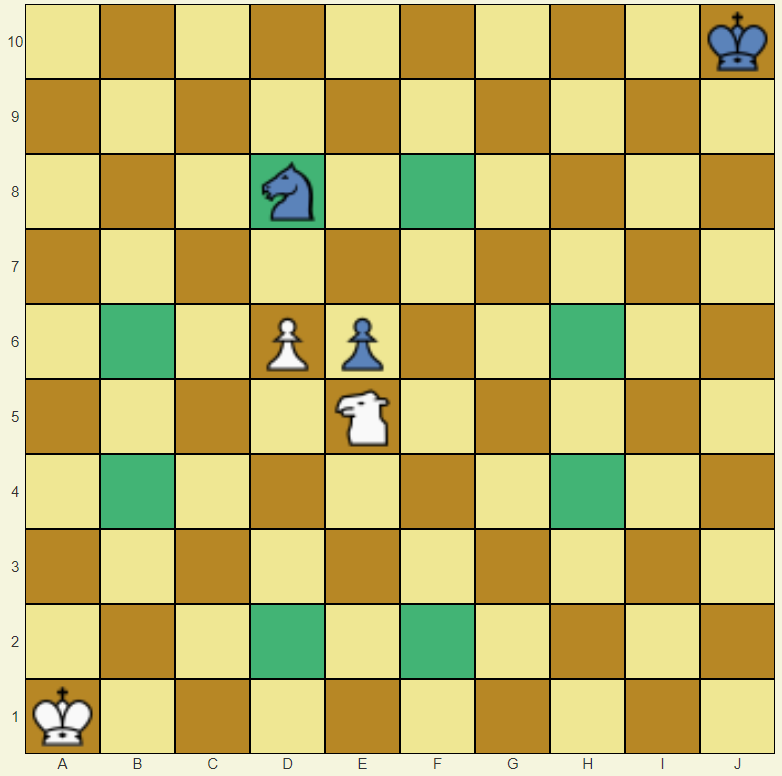
The camel is a jumper(3,1): it moves and captures three squares vertically and one square horizontally, or three squares horizontally and one square vertically.
It "jumps", i.e., it can move regardless whether there are pieces on the intervening squares.
Diagram: white camel can move to any empty green square or can capture black knight.
|
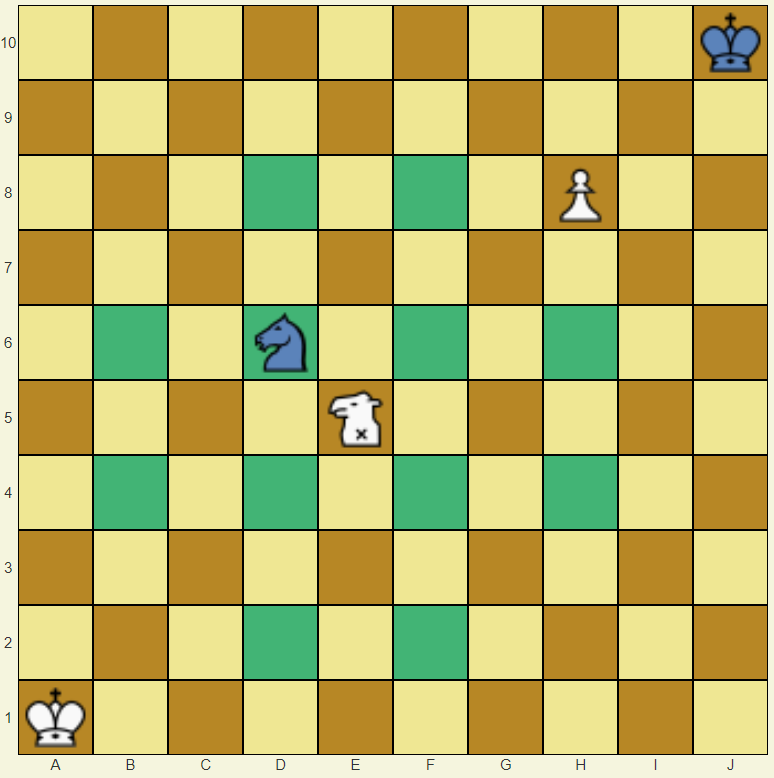
The camel-ferz moves and captures like camel (jumper(3,1)) or like ferz (one square diagonally).
Diagram: white camel-ferz can move to any empty green square or can capture black knight.
|
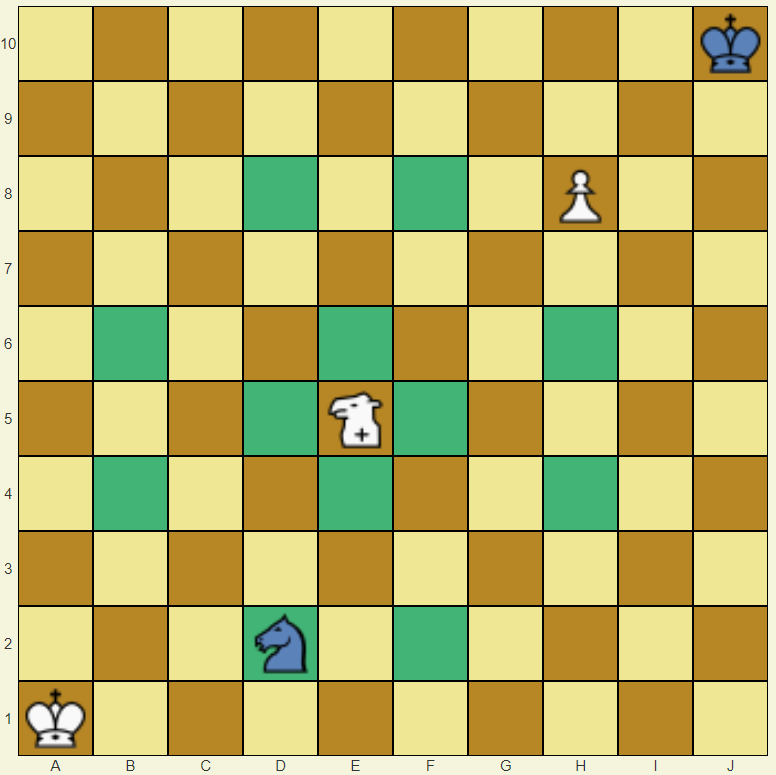
The camel-wazir moves and captures like camel (jumper(3,1)) or like wazir (one square orthogonally).
Diagram: white camel-wazir can move to any empty green square or can capture black knight.
|
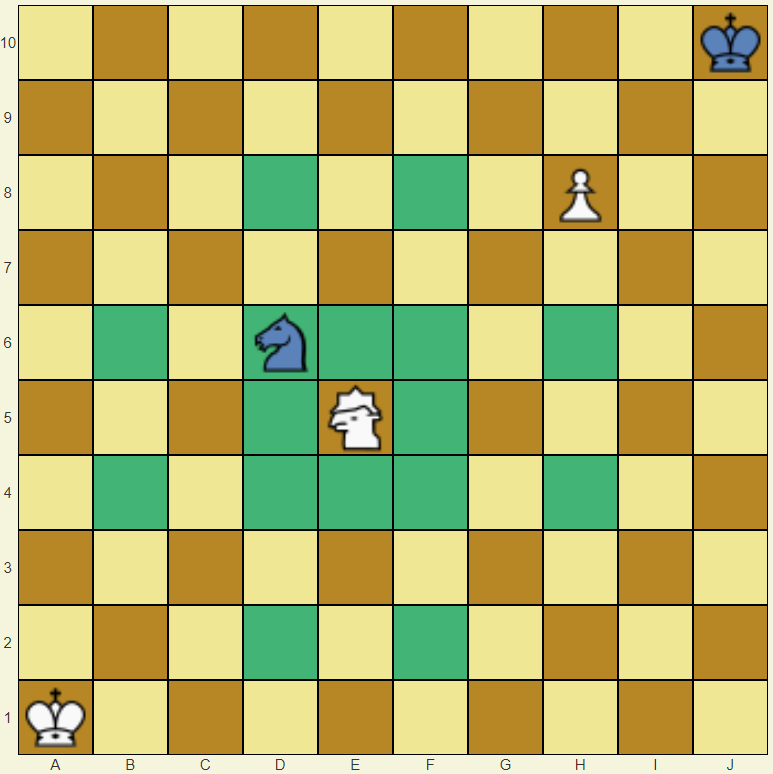
The camel-guard moves and captures like camel (jumper(3,1)) or like guard (one adjacent square).
Diagram: white camel-guard can move to any empty green square or can capture black knight.
|
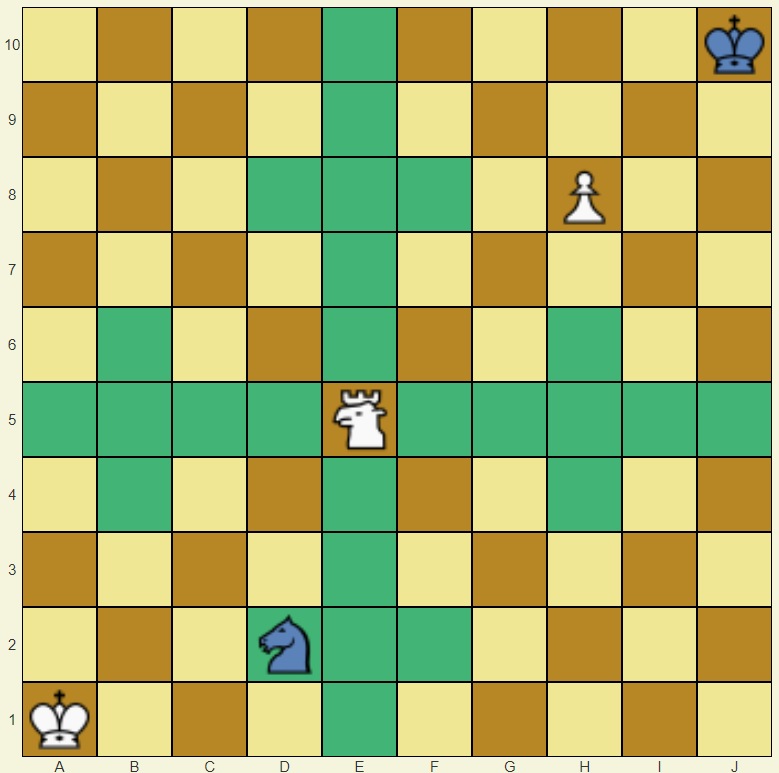
The camel-rook moves and captures like camel (jumper(3,1)) or like rook.
Diagram: white camel-rook can move to any empty green square or can capture black knight.
|

The giraffe is a jumper(4,1): it moves and captures four squares vertically and one square horizontally, or four squares horizontally and one square vertically.
It "jumps", i.e., it can move regardless whether there are pieces on the intervening squares.
The giraffe can give a check on move 1 so it is frozen for the first 5 moves so the players can take care of potential threats.
Diagram: white giraffe can move to any empty green square or can capture black knight.
|

The zebra is a jumper(3,2): it moves and captures three squares vertically and two squares horizontally, or three squares horizontally and two squares vertically.
It "jumps", i.e., it can move regardless whether there are pieces on the intervening squares.
Diagram: white zebra can move to any empty green square or can capture black knight.
|
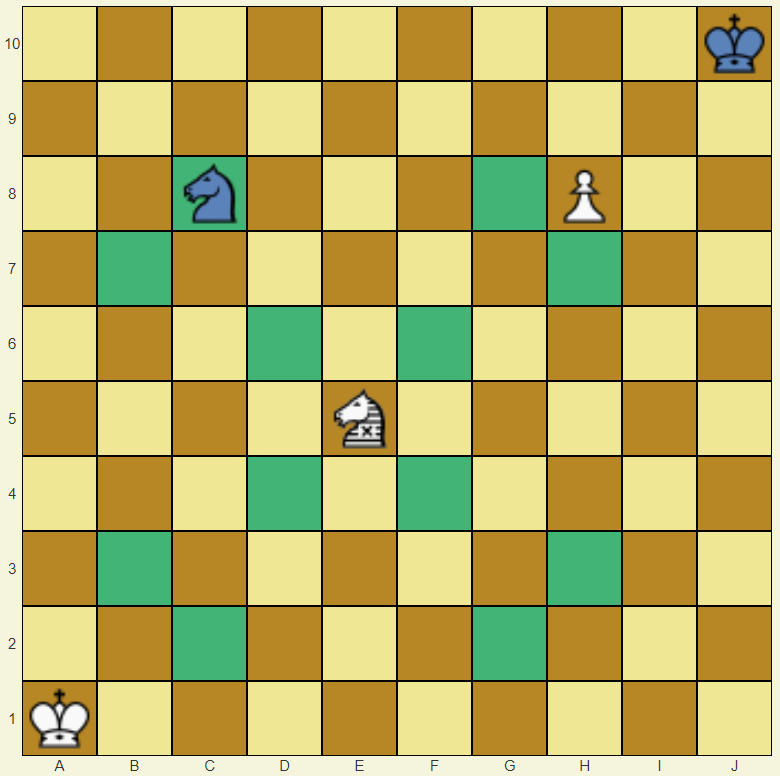
The zebra-ferz moves and captures like zebra (jumper(3,2)) or like ferz (one square diagonally).
Diagram: white zebra-ferz can move to any empty green square or can capture black knight.
|
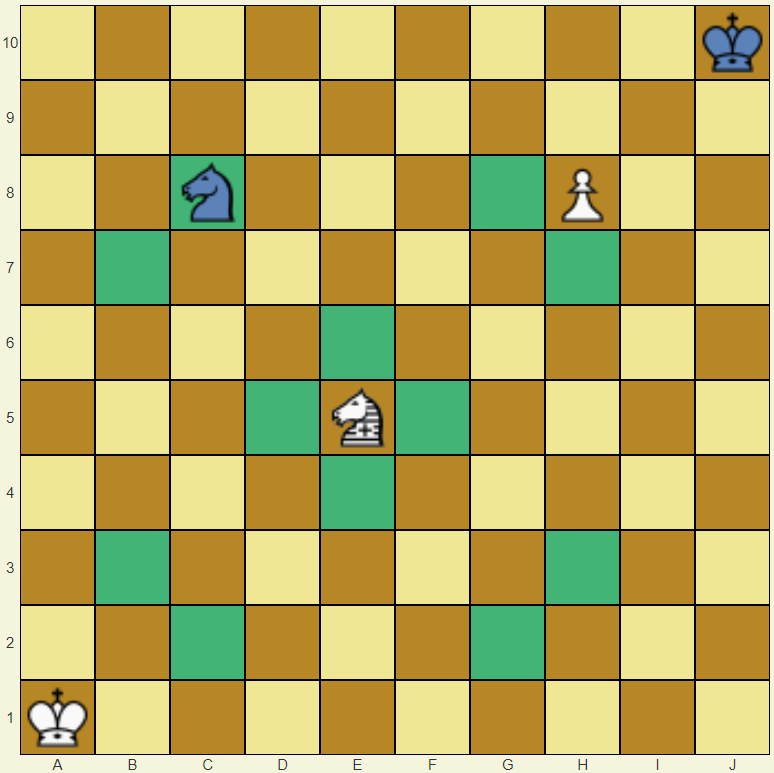
The zebra-wazir moves and captures like zebra (jumper(3,2)) or like wazir (one square orthogonally).
Diagram: white zebra-wazir can move to any empty green square or can capture black knight.
|
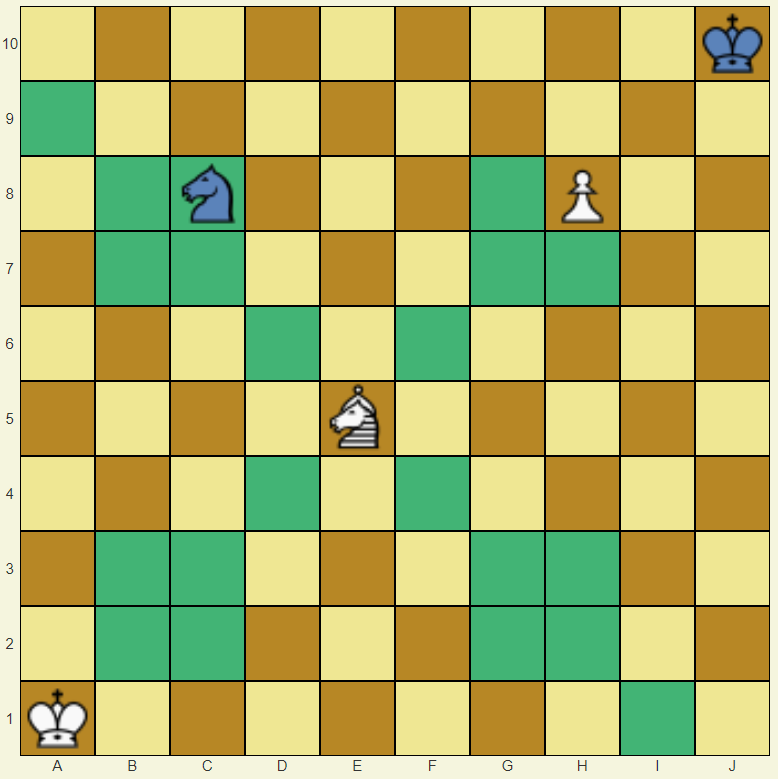
The zebra-bishop moves and captures like zebra (jumper(3,2)) or like bishop.
Diagram: white zebra-bishop can move to any empty green square or can capture black knight.
|
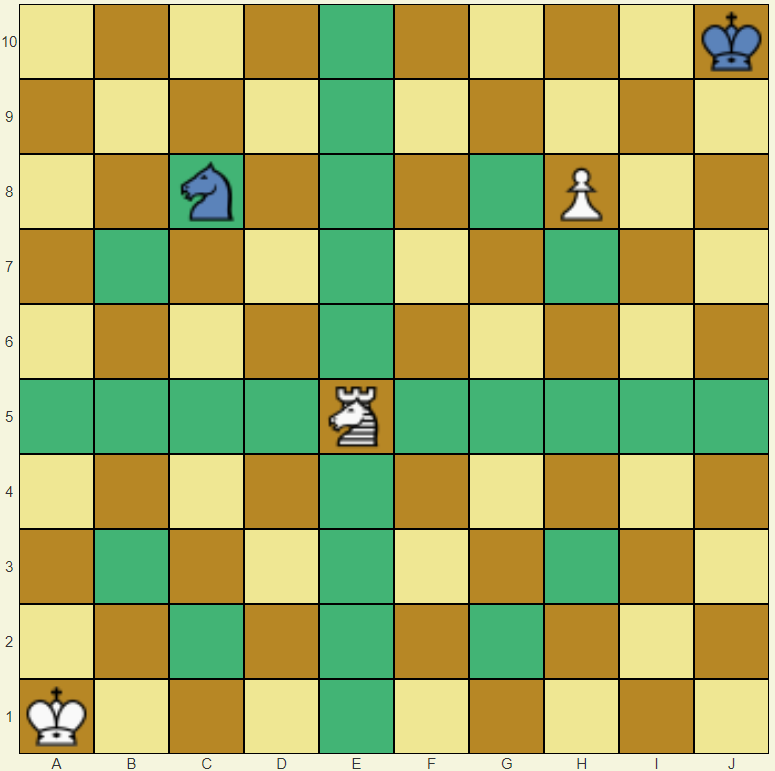
The zebra-rook moves and captures like zebra (jumper(3,2)) or like rook.
Diagram: white zebra-rook can move to any empty green square or can capture black knight.
|
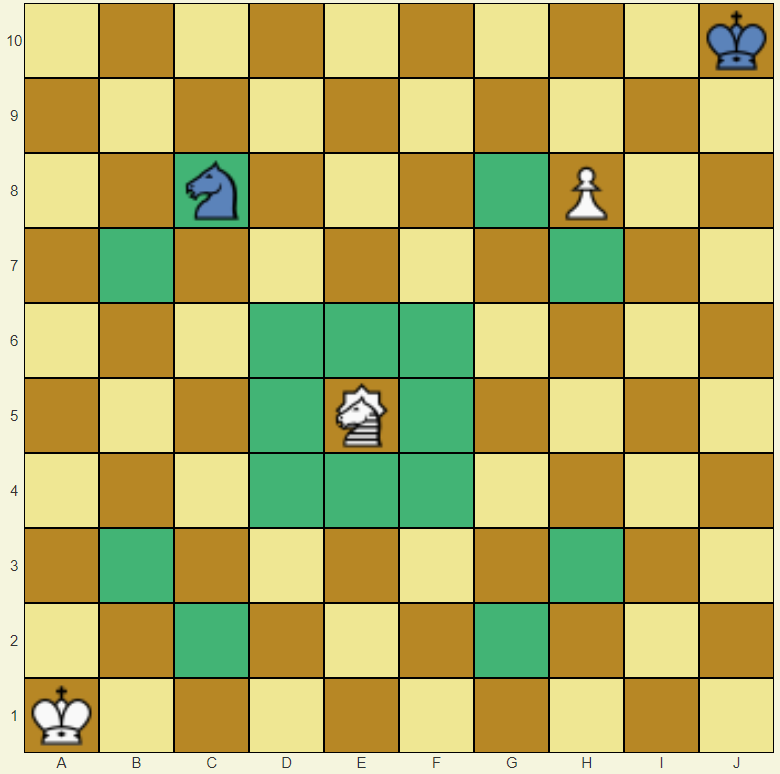
The zebra-guard moves and captures like zebra (jumper(3,2)) or like guard (one adjacent square).
Diagram: white zebra-guard can move to any empty green square or can capture black knight.
|
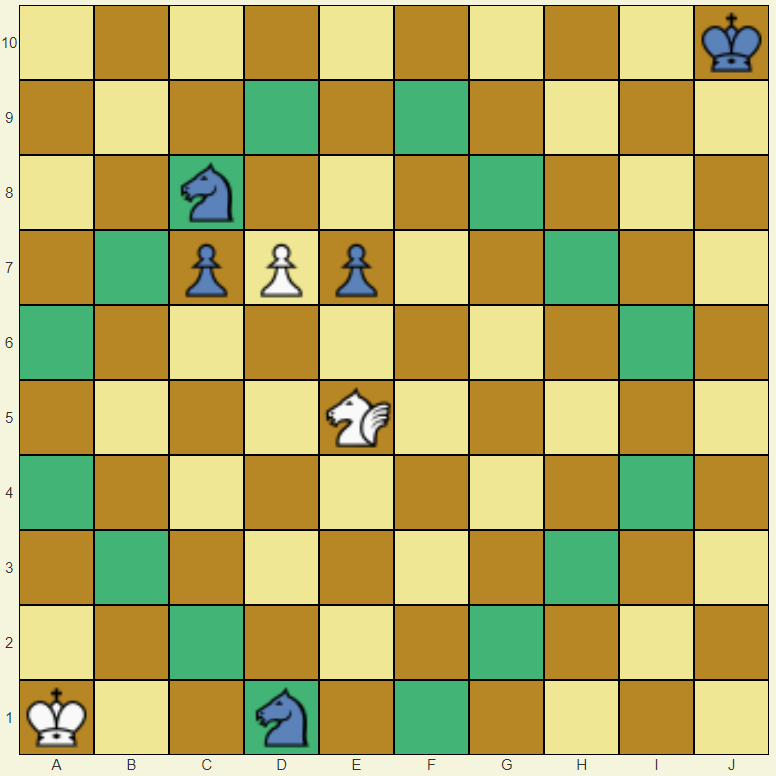
The pegasus moves and captures like zebra (jumper(3,2)) or like giraffe (jumper(4,1)).
The pegasus can give a check on move 1 so it is frozen for the first 5 moves so the players can take care of potential threats.
Diagram: white pegasus can move to any empty green square or can capture any of black knights.
|
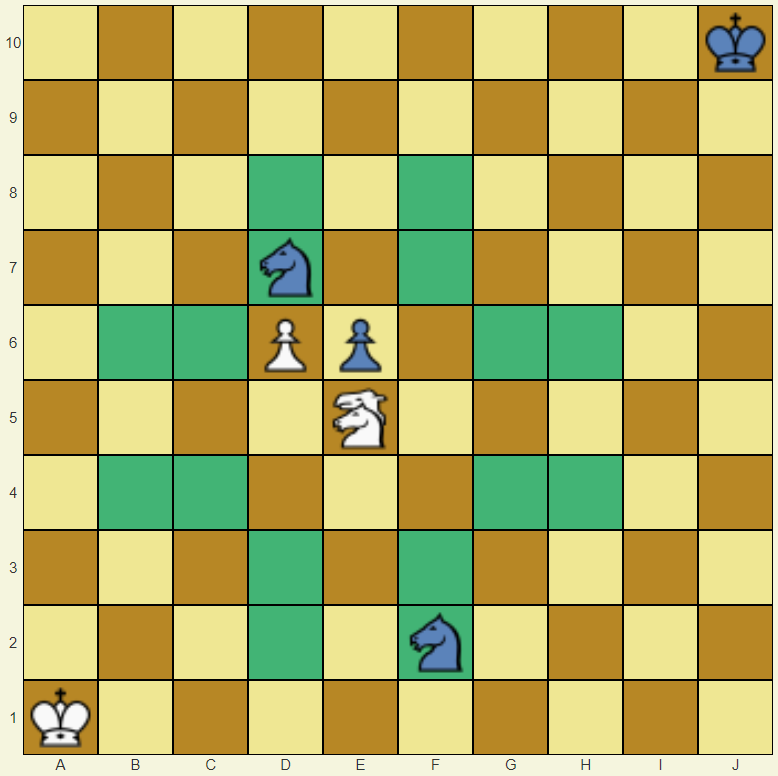
The wildebeest moves and captures like knight (jumper(2,1)) or like camel (jumper(3,1)).
Diagram: white wildebeest can move to any empty green square or can capture any of black knights.
|
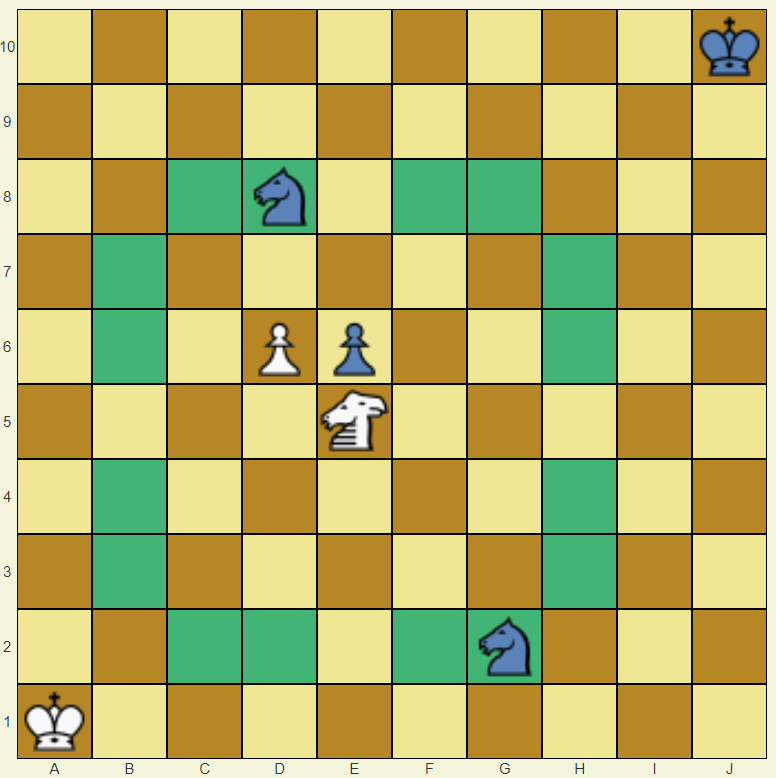
The camel-zebra moves and captures like camel (jumper(3,1)) or like zebra (jumper(3,2)).
Diagram: white camel-zebra can move to any empty green square or can capture any of black knights.
|
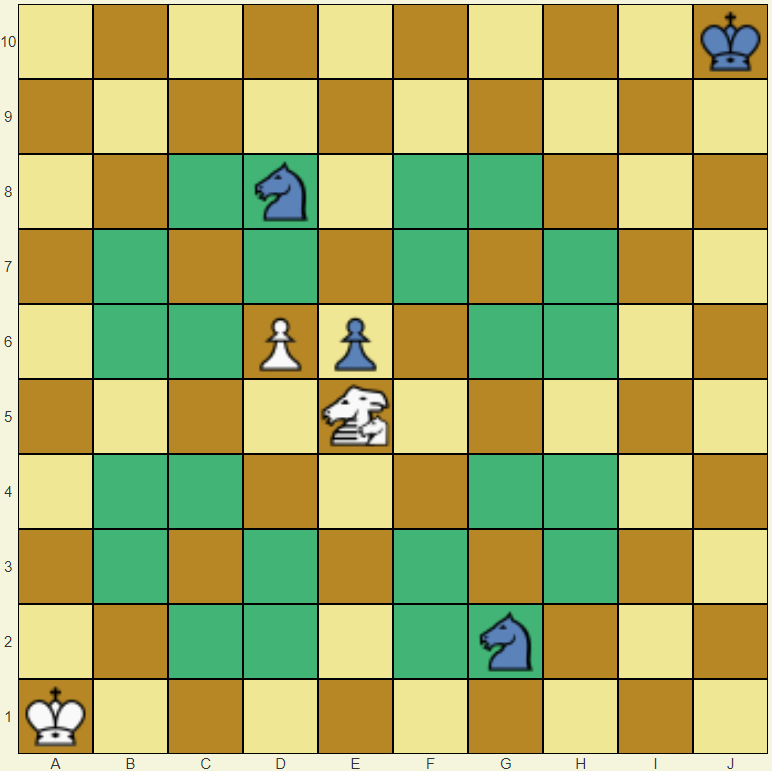
The knight-camel-zebra moves and captures like knight (jumper(2,1)) or like camel (jumper(3,1)) or
like zebra (jumper(3,2)).
Diagram: white knight-camel-zebra can move to any empty green square or can capture any of black knights.
|
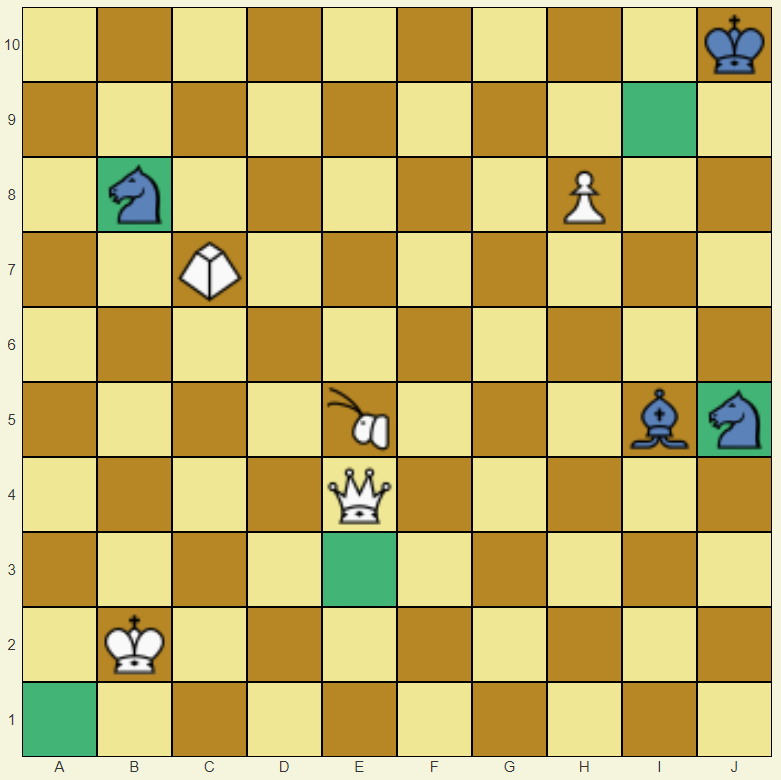
The grasshopper moves on the queen's lines, but must jump and lands at the first square after the piece he jumps.
To be precise: the grasshopper moves in horizontal, vertical or diagonal direction until it meets a piece (either friendly or unfriendly).
It jumps over the piece and goes to the first square on the line after the piece that it jumped over.
If that square is occupied by a piece from the opponent, that piece is captured, i.e., the grasshopper captures in the same way as it moves without taking.
The grasshopper can give a check on move 1 so it is frozen for the first 5 moves so the players can take care of potential threats.
Diagram: white grasshopper can move to any empty green square or can capture any of black knights.
|
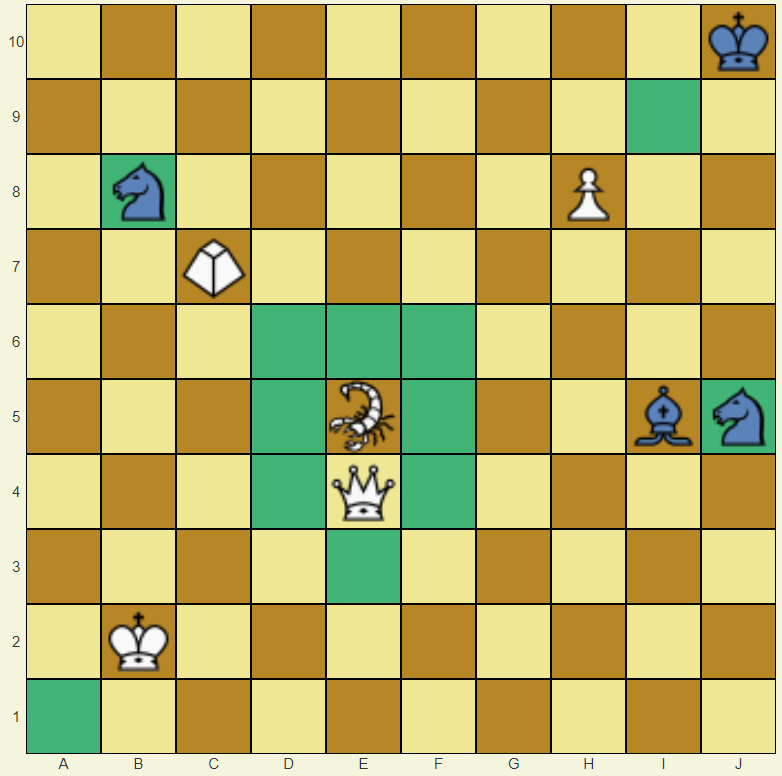
The scorpion moves and captures like guard (one adjacent square) and like grasshopper.
The scorpion can give a check on move 1 so it is frozen for the first 5 moves so the players can take care of potential threats.
Diagram: white scorpion can move to any empty green square or can capture any of black knights.
|

The hero is an inclusive compound of dabbaba and wazir.
It may: step 1 square like wazir; or jump 2 squares like dabbabah; or step 1 and jump 2 squares; or jump 2 squares then step 1 more square, always orthogonally.
It may change direction during its move.
All destinations have two paths leading to it (e.g. the hero can step 1 right and jump 2 up or jump 2 up and step 1 right).
For destination to be inaccessible both first parts need to be blocked.
Diagram: white hero can move to any empty green square or can capture any of black knights.
Note: The hero can not move to H5 because both black knights are blocking the first part of both paths leading there.
|
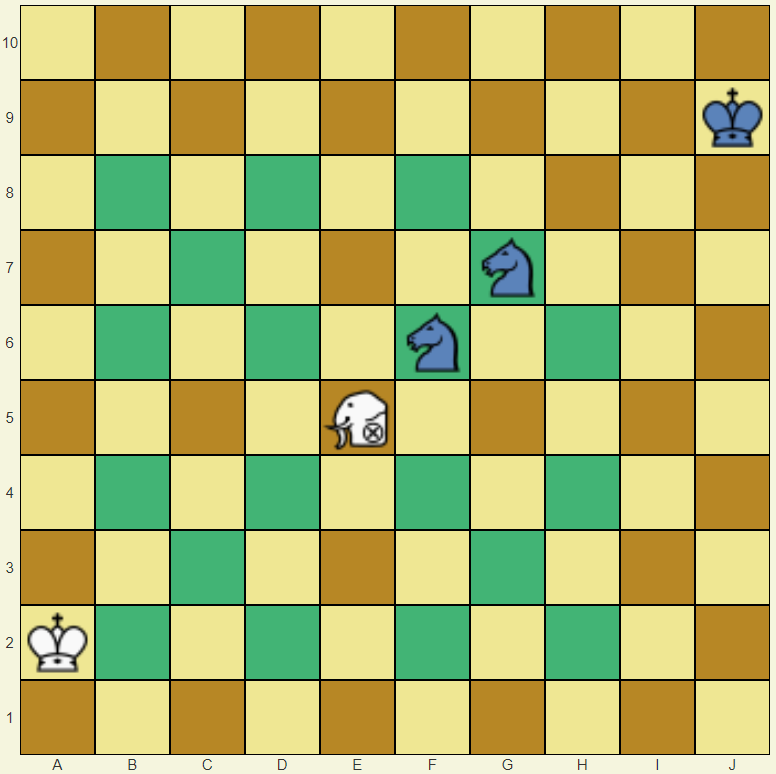
The shaman is an inclusive compound of elephant and ferz.
It may: step 1 square like ferz; or jump 2 squares like elephant; or step 1 and jump 2 squares; or jump 2 squares then step 1 more square, always diagonally.
It may change direction during its move.
All destinations have two paths leading to it (e.g. the shaman can step 1 right-up and jump 2 left-up or jump 2 left-up and step 1 right-up).
For destination to be inaccessible both first parts need to be blocked.
Diagram: white shaman can move to any empty green square or can capture any of black knights.
Note: The shaman can not move to H8 because both black knights are blocking the first part of the path leading there.
|

The block moves in the eight directions, up-to-three squares. A Block can't capture, or be captured.
Diagram: white block can move to any empty green square and can't capture black knight.
|

The butterfly moves and captures as a knight, except it can move one space diagonally backwards instead of being able to make
the knight's two rear-most moves, and it can move like a camel sideways in a forward direction instead of being able to make
the knight's two sideways moves that are also forward.
Diagram: white butterfly can move to any empty green square or can capture black knight.
|

The crab moves and captures like a knight, jumping across squares, but only in some directions: it can go either two squares vertically
forwards and one square horizontally, or one square vertically backwards and two squares horizontally.
Diagram: white crab can move to any empty green square or can capture black knight.
|

The dragon moves and captures like a rook or the dragon can step one square diagonally and then continue like dabbaba-rider.
The dragon can give a check on move 1 so it is frozen for the first 5 moves so the players can take care of potential threats.
Diagram: white dragon can move to any empty green square or can capture black knight.
|
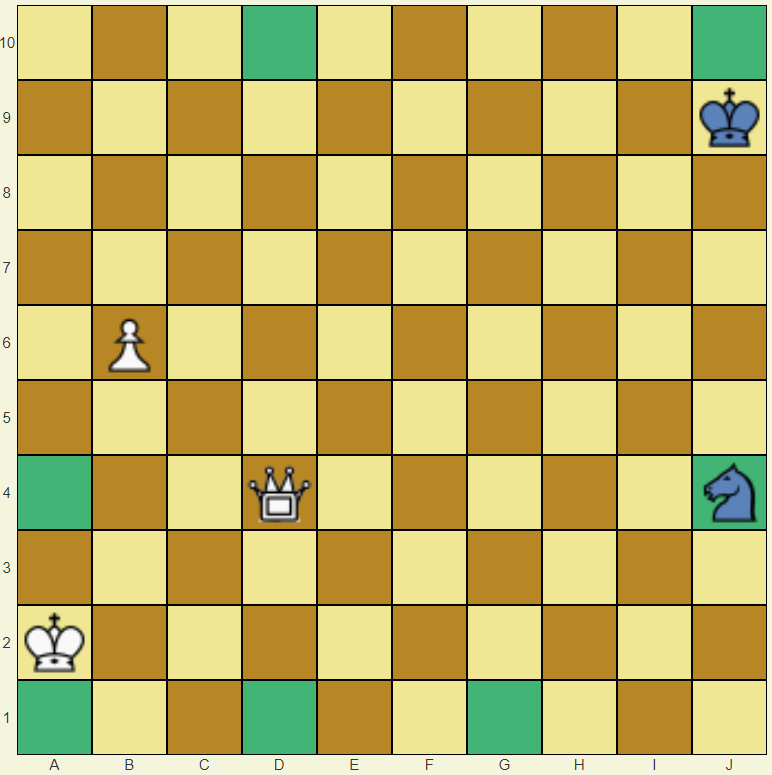
The edgehog is a limited queen. It moves an arbitrary number of squares in a horizontal, vertical, or diagonal direction, but may not jump over occupied squares,
and must either begin or end on an edge square.
Diagram: white edgehog can move to any empty green square or can capture black knight.
|
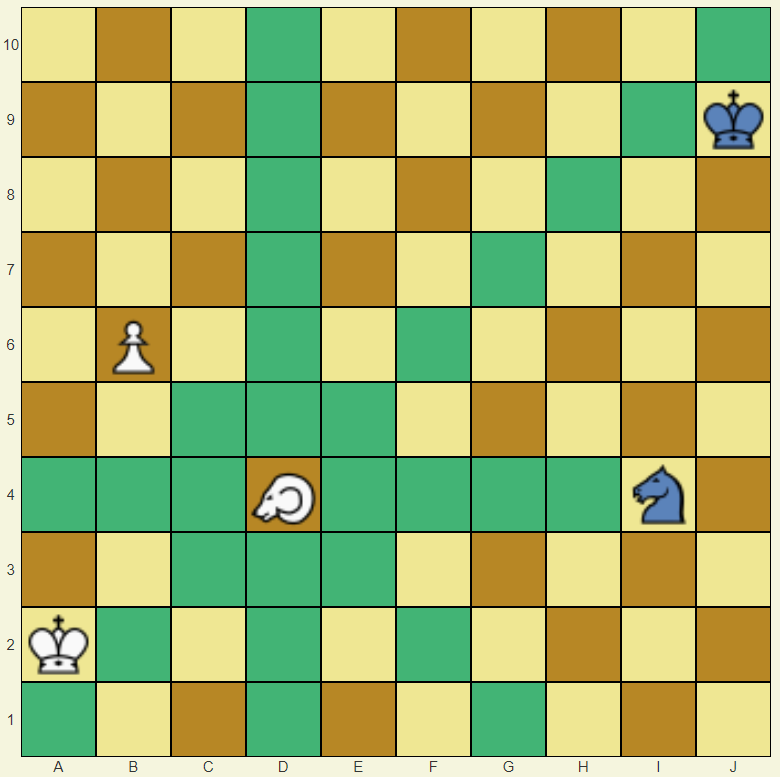
Advancer moves passively as a queen. In order to capture, the Advancer must move to a square adjacent to an enemy piece.
If the next square in the direction it moved from the square the Advancer stopped on is occupied by an opposing piece, that opposing piece is captured.
(This is capture by approach.) These captures are part of movement, and are not optional - you can not move an Advancer next to an opposing piece in the
line of movement and not capture it. An Advancer never moves into an occupied square.
Diagram: white advancer can move to any empty green square. If the advancer moves to H4, additionally it captures black knight on I4.
|
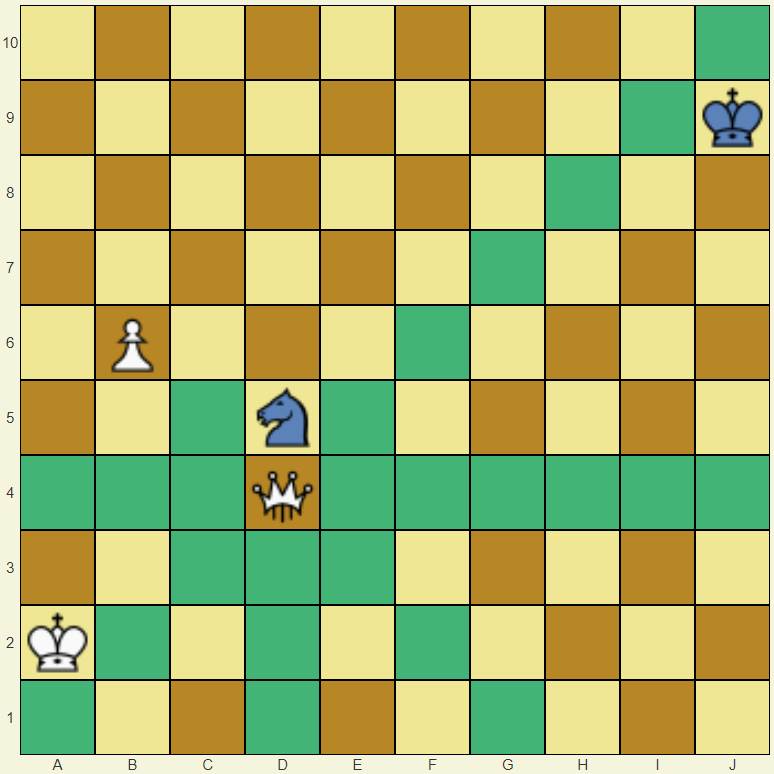
Withdrawer moves passively as a queen. In order to capture, the Withdrawer must occupy a square adjacent to an enemy piece.
To complete the capture, it must move one-or-more squares directly away from the enemy piece.
These captures are part of the movement, and are not optional -- you can not move a Withdrawer directly away from an opposing piece and not capture it.
A Withdrawer may never move to an occupied square.
Diagram: white withdrawer can move to any empty green square. If the withdrawer moves to D3, D2 or D1, additionally it captures black knight on D5.
|

The Duke can move in either of the following ways:
Step one square orthogonally, and then slide any number of squares diagonally.
Slide any number of squares diagonally, then step one square orthogonally.
In both cases the Duke has the additional restriction that it may not end its move on a square adjacent to the square on which it started.
It may not jump over other pieces, and captures the same way as it moves.
The options given for the Duke's movement both produce the same set of destination sqaures, but give it different paths to those squares.
Diagram: white duke can move to any empty green square or can capture any of black knights.
|

The frog is a compound piece that moves like a ferz (one square diagonally) or a jumper(3,0)
(i.e. jumps exactly three squares orthogonally, meaning on a rank or file).
Diagram: white frog can move to any empty green square or can capture black knight.
|
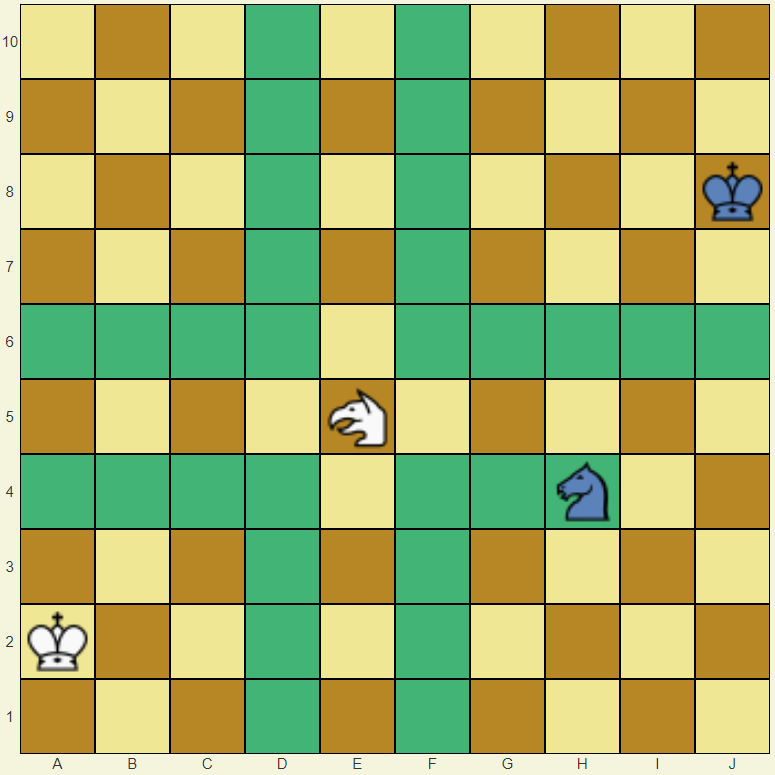
The gryphon steps one space diagonally then slides like a rook outwards. It captures the same way as it moves.
Diagram: white gryphon can move to any empty green square or can capture black knight.
|

The kangaroo moves on the queen lines, but must jump over two pieces and lands on the first square after the second piece it jumps.
To be precise: the kangaroo moves in horizontal, vertical or diagonal direction until it encounters a piece (either friendly or unfriendly),
it jumps over that piece and then continues on the same line until it encounters a second piece (also either friendly or unfriendly).
It jumps over that piece and goes to the first square on the line after the piece that it jumped over.
If that square is occupied by a piece from the opponent, that piece is taken, i.e., the kangaroo takes in the same way as it moves without taking.
The kangaroo can give a check on move 1 so it is frozen for the first 5 moves so the players can take care of potential threats.
Diagram: white kangaroo can move to any empty green square or can capture any of black knights.
|

The lion has both regular and capturing moves. It can jump (moving or capturing) two squares horizontally, vertically, or diagonally, ignoring anything in its path.
It can also capture by moving one space in any direction (like an orthodox king). But the lion cannot move only one space without capturing.
Diagram: white lion can move to any empty green square or can capture any of black knights.
|
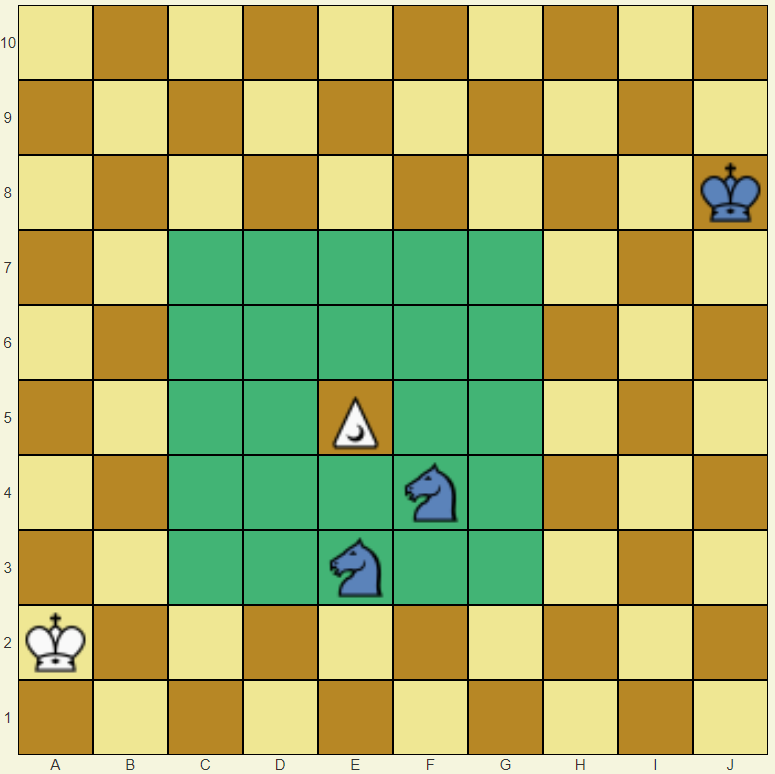
The mage moves as a guard (1 square in any direction), or may jump to a position 2 squares away, jumping in any orthogonal or diagonal direction,
or the mage can jump as a knight (jumper(2,1)) and it does not matter what unit intermediate squares contain.
The mage captures as it moves.
Diagram: white mage can move to any empty green square or can capture any of black knights.
|
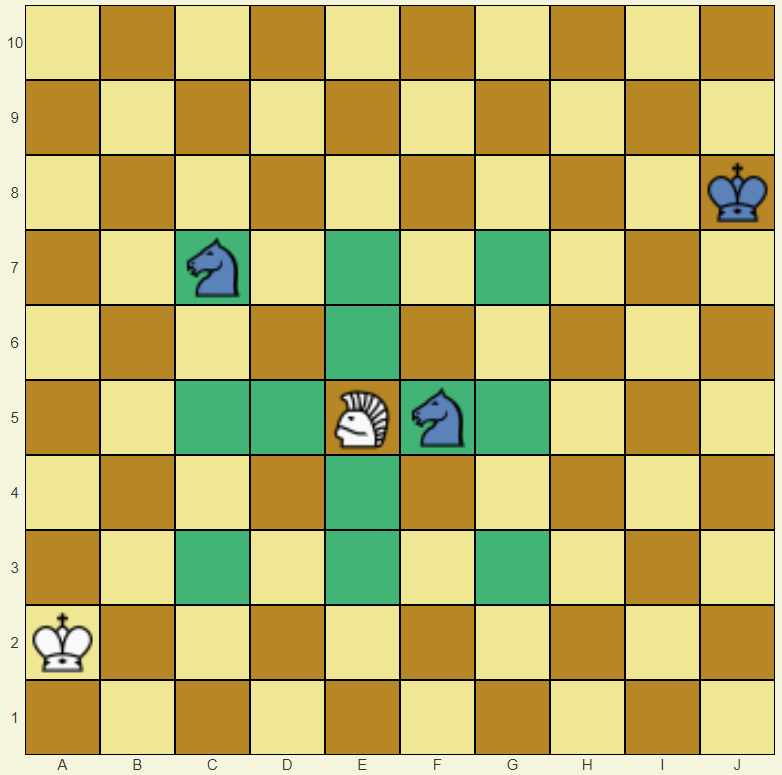
The champion has the combined movements of the wazir, the elephant,
and the dabbaba.
More specifically, the champion has one of the two following options:
- it can move a single square in any orthogonal direction.
- it can move exactly two squares in any orthogonal or diagonal direction, regardless of intervening pieces.
The champion captures as it moves.
Diagram: white champion can move to any empty green square or can capture any of black knights.
|

The squirrel jumps to a position 2 squares away, jumping in any orthogonal or diagonal direction,
or the squirrel can jump as a knight (jumper(2,1)) and it does not matter what unit intermediate squares contain.
The squirrel captures as it moves.
Diagram: white squirrel can move to any empty green square or can capture any of black knights.
|
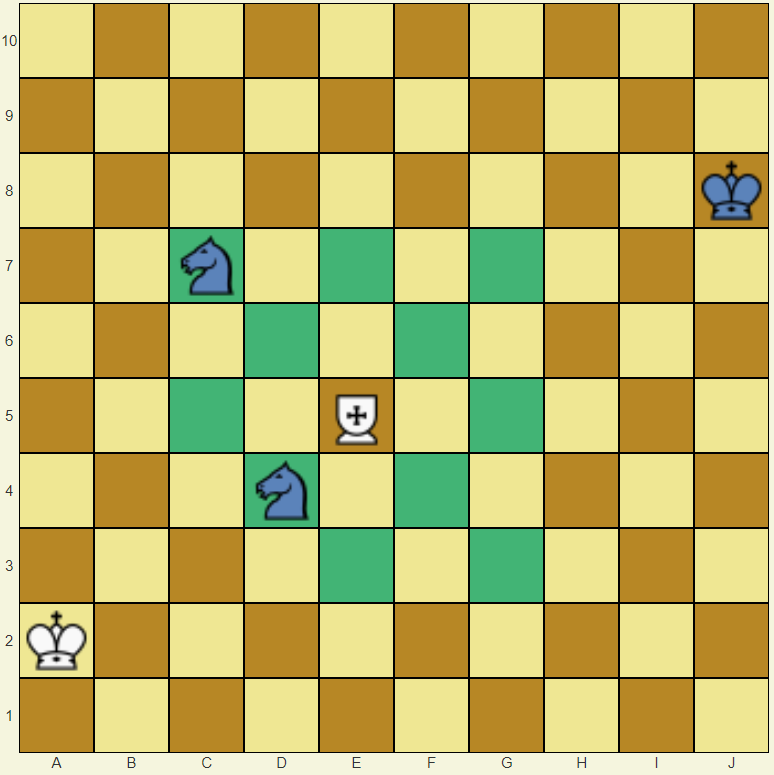
The templar is a colorbound piece which may move like dabbaba (jumper(2,0)) or slide one or two squares
diagonally (as a bishop).
The templar captures as it moves.
Diagram: white templar can move to any empty green square or can capture any of black knights.
|
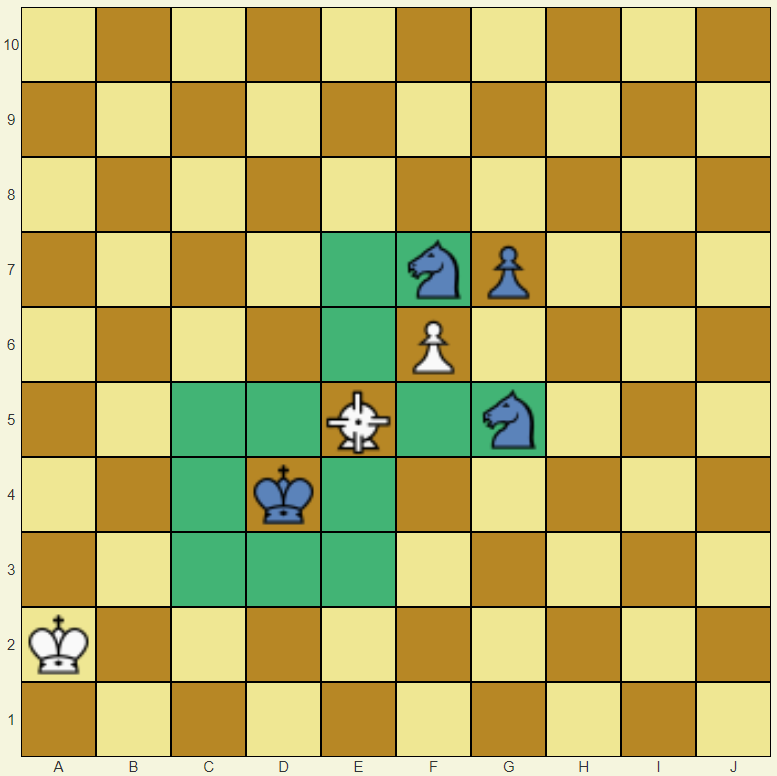
The windmill moves as follows: first it chooses a piece, friendly or enemy, adjacent to itself.
The windmill can then move either clockwise or counterclockwise around that piece, passing through empty squares adjacent to the piece around which the windmill is moving.
The windmill can end on an enemy piece, capturing it. The windmill must end on a square different than the one it started on.
If there are no adjacent pieces near windmill, then it cannot move.
Diagram: white windmill can move to any empty green square or can capture any of black knights.
|

The tiger jumps as a zebra (jumper(3,2)) and may then slide outward as a bishop.
The tiger can give a check on move 1 so it is frozen for the first 5 moves so the players can take care of potential threats.
Diagram: white tiger can move to any empty green square or can capture black knight.
|

When the cannon does not capture, it moves like a rook, i.e., on an orthogonal line an arbitrary number of empty squares.
When it captures, it must jump: when capturing, the cannon also moves over an orthogonal line, jumps over the first piece it meets (which may either be friendly or from the opponent)
and then continues over the line until the next piece it sees: if that is from the opponent, the cannon can capture it by moving to that position.
The cannon can give a check on move 1 so it is frozen for the first 5 moves so the players can take care of potential threats.
Diagram: white cannon can move to any empty green square or can capture any of black knights.
|
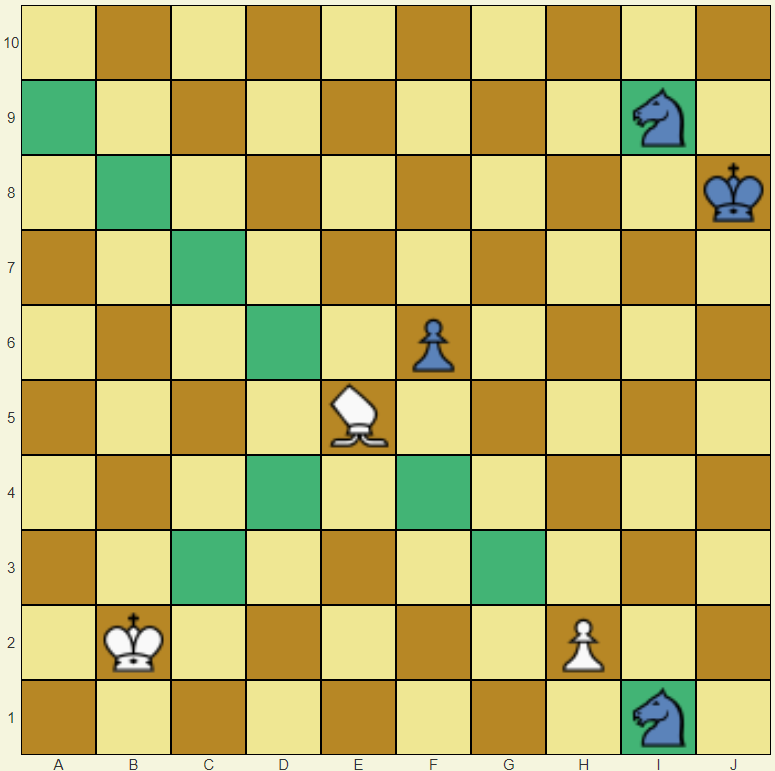
When the vao does not capture, it moves like a bishop, i.e., on a diagonal line an arbitrary number of empty squares.
When it captures, it must jump: when capturing, the vao also moves over a diagonal line, jumps over the first piece it meets (which may either be friendly or from the opponent)
and then continues over the diagonal line until the next piece it sees: if that is from the opponent, the vao can capture it by moving to that position.
The vao can give a check on move 1 so it is frozen for the first 5 moves so the players can take care of potential threats.
Diagram: white vao can move to any empty green square or can capture any of black knights.
|

When the leo does not capture, it moves like a queen, i.e., on a diagonal or othogonal line an arbitrary number of empty squares.
When it captures, it must jump: when capturing, the leo moves along an orthogonal or diagonal line, jumps over the first piece it meets (which may either be friendly or from the opponent)
and then continues moving like a queen until the next piece it sees: if that is from the opponent, the leo can capture it by moving to that position.
The leo can give a check on move 1 so it is frozen for the first 5 moves so the players can take care of potential threats.
Diagram: white leo can move to any empty green square or can capture any of black knights.
|
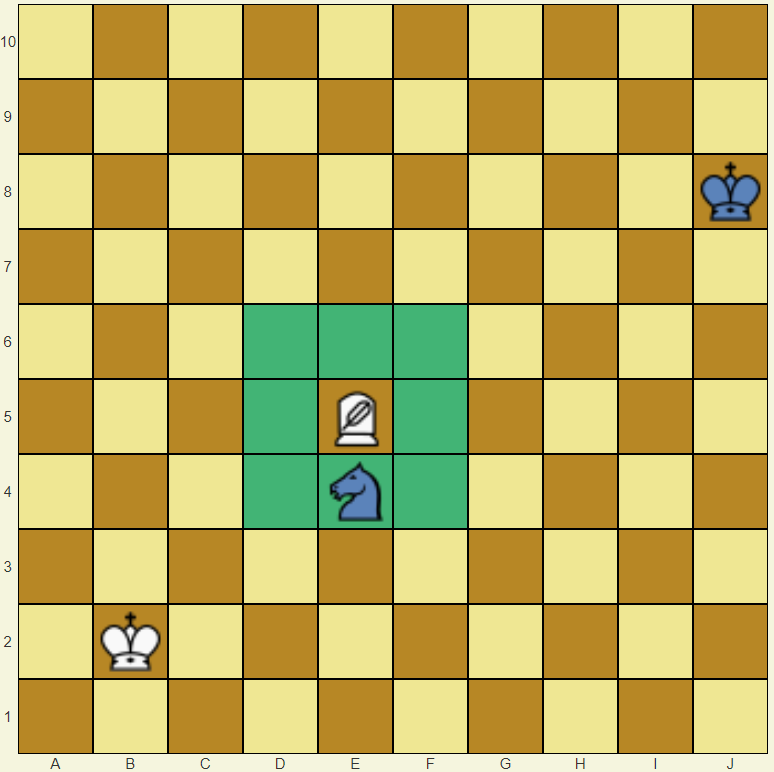
When the diplomat does not capture, it moves like a guard, i.e., on an adjacent square.
The diplomat can capture an adjacent opponent piece by converting its color - the captured piece changes sides.
If there are two or more pieces adjacent to it at the beginning of its turn, the diplomat can capture only one one of them.
After the turn the diplomat appears to remain on the same cell where it was standing before, and the only thing that has happened is that one piece has changed its colour.
The diplomat cannot convert a block as it cannot be captured.
Diagram: white diplomat can move to any empty green square or can capture black knight making it white knight instead.
|
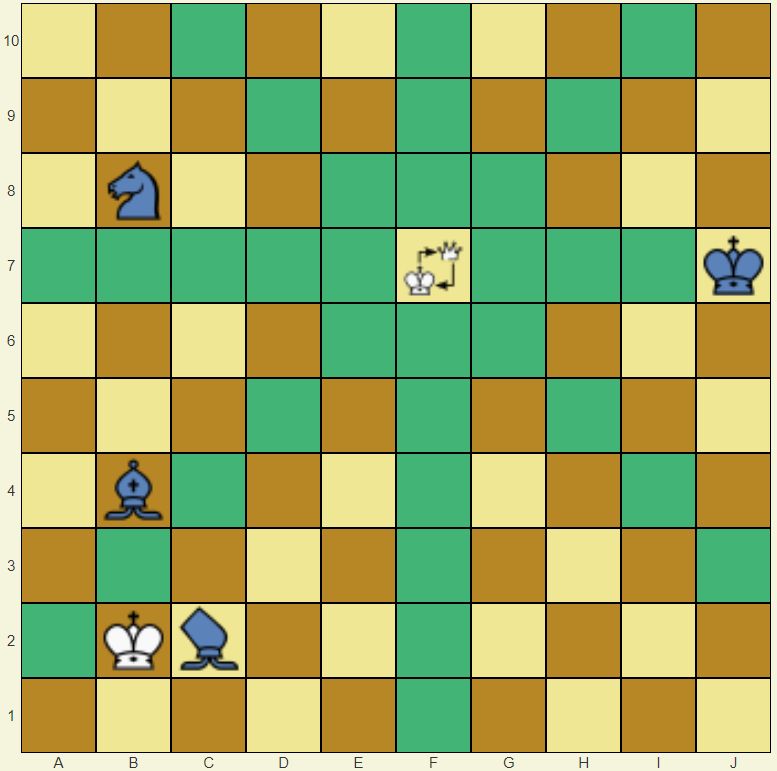
The coordinator moves as a queen. At the end of its move, any enemy piece that is on the same file as the coordinator and
same rank as the friendly king, or on the same rank as the coordinator and the same file is the king, is captured.
The coordinator can never move to an occupied square.
Note that it is possible for the coordinator to capture two pieces in one move.
Diagram: white coordinator can move to any empty green square. Additionally, if it moves to E8, F8 or G8, it captures knight B8.
If the coordinator moves to C4 it captures two pieces: bishop B4 and vao C2.
If the coordinator moves to B7, it does not capture anything.
If the black king was placed instead of the knight B8, then the resulting position would be illegal as white coordinator could capture the black king
by moving to E8, F8 or G8. If it was black to move, then the black king would be in check and would need to eliminate the threat by moving
away from B file.
|
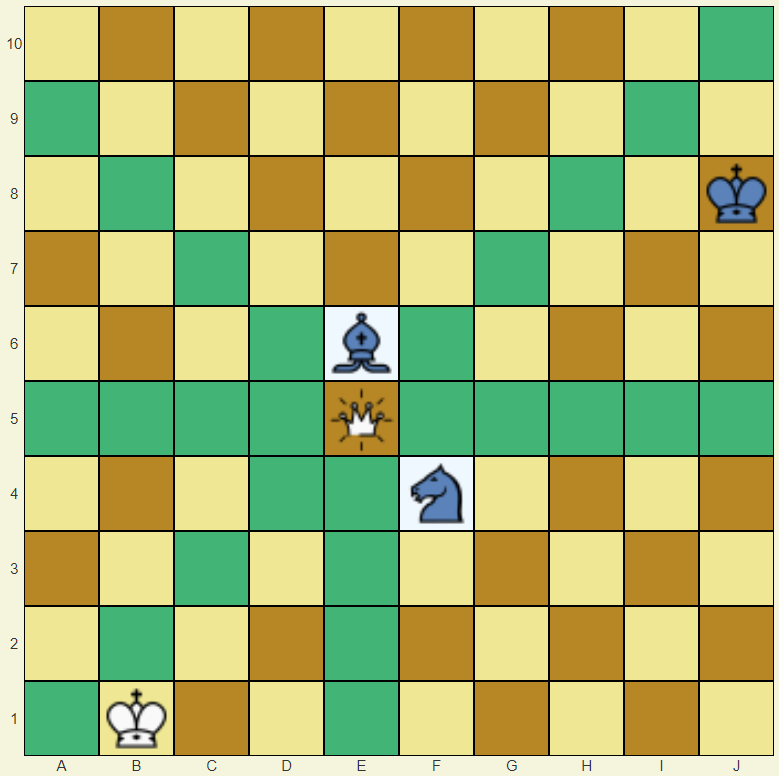
The immobilizer moves as a queen but does not capture.
An enemy piece standing adjacent to an immobilizer may not move while the immobilizer is present.
Consequently immobilized piece cannot give check.
Black and white immobilizers, occupying adjacent squares, are each frozen until the other is captured.
Diagram: white immobilizer can move to any empty green square. Additionally, while immobilizer does not move away, nearby by black bishop and knight are not allowed to move.
|
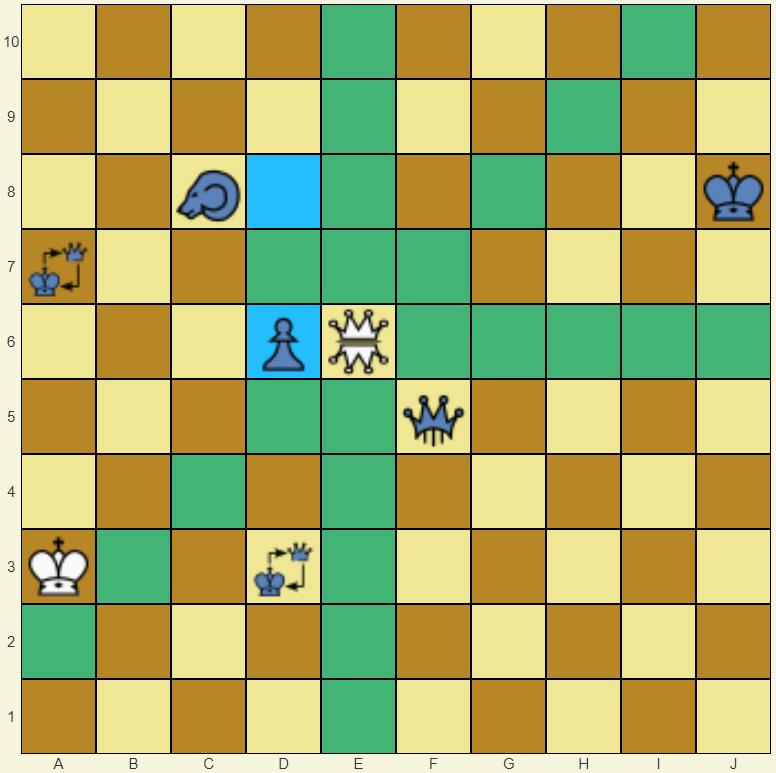
The chameleon moves passively as a queen. To capture, it mimics the powers of its intended victim.
For example, it withdraws from withdrawers, approaches advancers,
captures a knight with 2,1 jump, switches adjacent diplomat's colour,
captures a pawn by moving one square diagonally forward.
By the same token, an enemy king standing adjacent to a chameleon is attacked by the chameleon.
Chameleon can freeze immobilizer but cannot capture it (but when next to an immobilizer do not freeze any other pieces).
A Chameleon can use multiple types of capture in the same move.
Chameleon does not promote if it captures a pawn in pawn promotion zone.
Chameleon cannot capture a fool.
Diagram: white chameleon can move to any empty green square. Additionally, if it moves to D7, chameleon captures pawn d6 (with en passant, as the last move is indicated by blue squares),
also withdrawer F5, advancer C8, coordinator A7 and coordinator D3. Five enemy pieces with one move get captured!
If it moves to E7 or F7 then coordinator A7 is captured.
If it moves to D5, then coordinator D3 is captured.
|
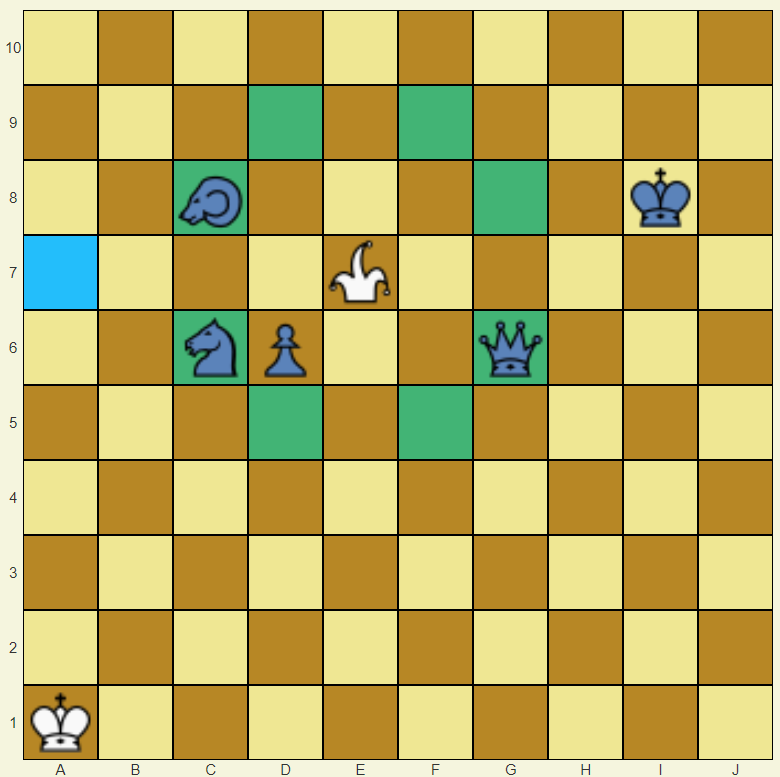
The fool can move and capture like the last piece moved by the opponent. E.g., when the opponent has played with a knight,
the player can make a knight-move with the fool.
(No distinction is made for moves that take a piece or that do not take.)
When moving like a king, the fool is not hindered by check: it is never royal.
The fool does not move if opponent moved chameleon.
The fool can not be captured for 1 turn if it copies the block's move.
The fool immobilizies adjacent opponent pieces for 1 turn only if it copies the immobilizer's move.
The fool can promote to another piece if it copies the pawn move and ends its movement in promotion zone.
If the last piece moved was opponent fool, the fool imitates the piece that opponent fool was imitating - the piece that moved before that.
Diagram: here black played knight A7-C6 with the last move. So the fool E7 can move like a knight to any empty green square. The fool can capture the knight C6 or the
advancer C8 or the queen G6.
|